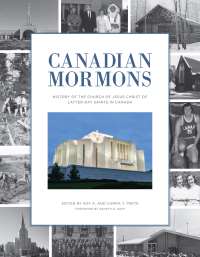Calgary
Linda S. Davis
Linda S. Davis, “Calgary,” in Canadian Mormons: History of the Church of Jesus Christ of Latter-Day Saints in Canada, ed. Roy A. and Carma T. Prete (Provo, UT: Religious Studies Center; Salt Lake City: Deseret Book, 2017), 242-275.
for many years: it was a place for business but not a place to live.
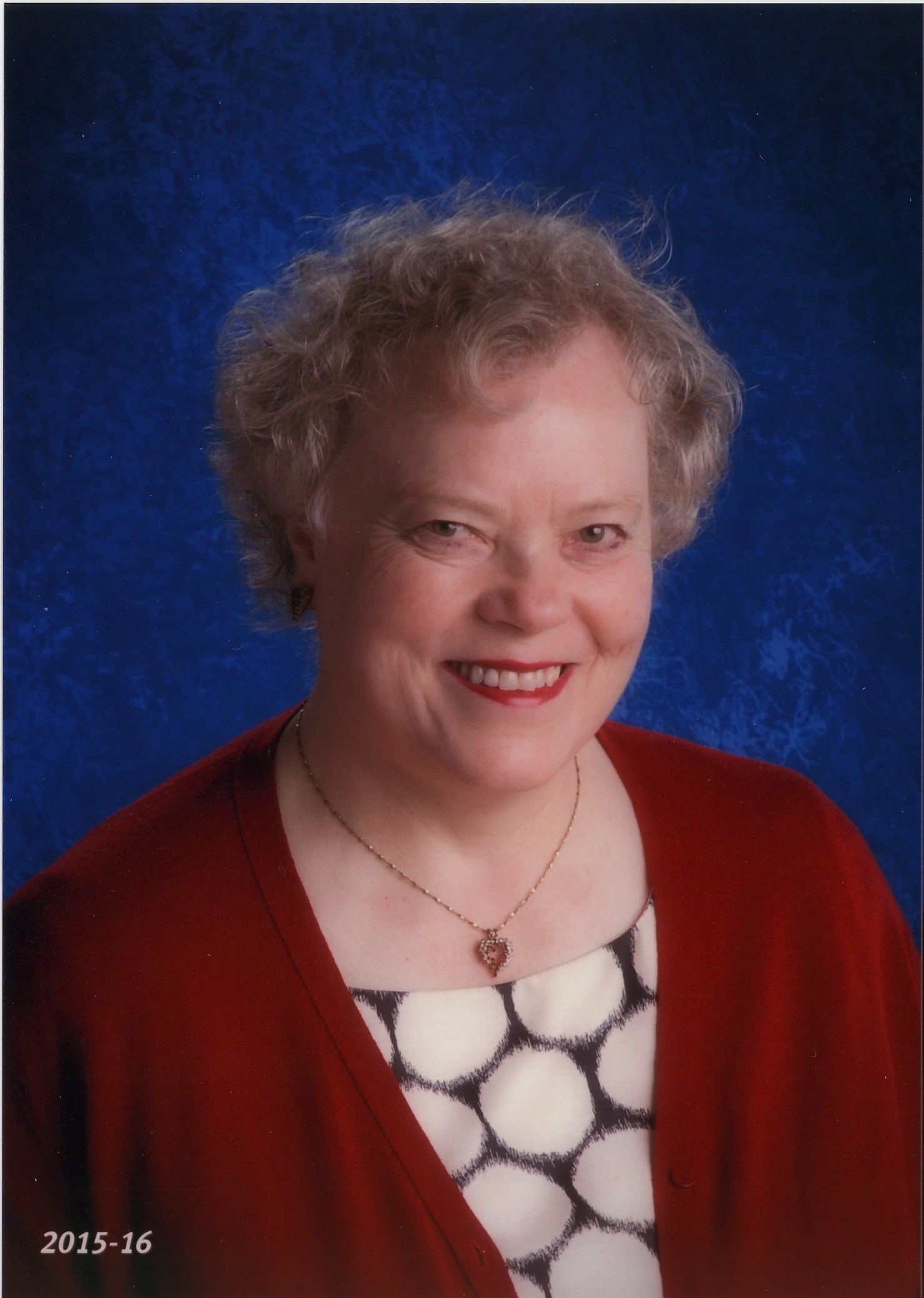
Linda Sharon Davis was born in Calgary and lived in various locations in Alberta until my parents were called on a building mission to Great Britain. The family lived there for seven years. She graduated from Brigham Young University with a BA in history and French, and later with a master of library science, and subsequently graduated from the University of Calgary with a BEd. She became a teacher, teacher-librarian, and principal with the Calgary Board of Education until her retirement in 2016. She served a mission in the Japan Sendai Mission and has served twice as Relief Society president and twice as Primary president, as well as in many teaching callings. Recently she served on the Calgary Temple Open House and Dedication Committee and chaired the Historical Committee. She is an enthusiastic family history researcher and enjoys reading, photography, and travel. (Linda Davis)
 By the end of 2015, Calgary had more stakes of the Church (seven) than any other city in Canada. While there were many struggles and challenges in the years after the arrival of the first Latter-day Saint families in 1910, the Church has experienced remarkable growth since the formation of the first stake in 1953. A gleaming midsized temple was dedicated in 2012 to serve the people in this growing metropolis and surrounding area.
By the end of 2015, Calgary had more stakes of the Church (seven) than any other city in Canada. While there were many struggles and challenges in the years after the arrival of the first Latter-day Saint families in 1910, the Church has experienced remarkable growth since the formation of the first stake in 1953. A gleaming midsized temple was dedicated in 2012 to serve the people in this growing metropolis and surrounding area.
The history of The Church of Jesus Christ of Latter-day Saints in Calgary is marked by a slow beginning with the arrival of a few Latter-day Saint families in 1910 and many struggles through the end of the Great Depression.[1] Formed as a dependent branch in 1913 and progressing to be an independent branch in 1921, the Calgary Ward was formed in 1923. Despite the meagre resources of the Saints, the ward managed to construct its first meetinghouse by 1939. With the prosperity of the postwar years, a substantial number of Latter-day Saints from southern Alberta moved to Calgary. The influx of Latter-day Saints along with an increase in convert baptisms after World War II enabled the formation of the Calgary Stake in 1953. Exponential growth in the following decades caused by a hot economy created a flourishing LDS community and intensified missionary work. This extraordinary growth resulted in the multiplication of stakes, until, by 2015, there were seven stakes in the city and its environs, with a total population of more than twenty-one thousand. The climax to this story of growth and expansion was the dedication of the Calgary Alberta Temple in 2012. This mid-sized temple provides the growing LDS population in the Calgary area with easy access to the highest spiritual blessings of church membership. Due to involvement and service, Church members has been well integrated into the community and the building of the temple was applauded in the media.
Beginnings
History and Economy
Nestled in the foothills of Alberta and just eighty kilometres east of the Rocky Mountains, Calgary was first settled in 1875 as Fort Brisebois, when Troop F of the North-West Mounted Police set up a post at the junction of the Bow and Elbow Rivers. The Canadian Pacific Railway laid out the town of Calgary west of the Elbow River and south of the Bow River in 1883. Incorporated in 1885, Calgary was “a thriving railroad town, surrounded by a large tract of rolling prairie country with very rich soils.” It became a city in 1893, twelve years before the province of Alberta was created in 1905.[2]
First Latter-day Saints
The first Latter-day Saints to visit Calgary—Charles Ora Card, J. W. Hendricks, and Isaac E. D. Zundell—arrived at 3:00 a.m. on Friday, 15 October 1886, in the middle of a severe snowstorm. Card, president of the Cache Valley Stake in Utah, had come to Canada at the request of President John Taylor to look for a place for the Saints to settle away from the persecution in the United States over polygamy.[3]
Card led a group of LDS settlers to southern Alberta in 1887, where Cardston and other settlements were established. In this early settlement period, no Latter-day Saints came to live in Calgary, 235 kilometres north of Cardston. During the next several years, Card and others visited Calgary on business.[4] Edward J. Wood often visited Calgary to attend bull sales and agricultural events. On Sunday, 28 October 1894, James May spoke of his recent trip to Calgary and his “association with men not of our faith,” stating that he was grateful to “return . . . to mingle with the Saints.”[5] This was the general feeling of Latter-day Saints towards Calgary
As Latter-day Saint settlers moved north of the Cardston-area settlements, though in widely scattered areas, they desired that units of the Church be established closer to their homes. Edward J. Wood, president of the Alberta Stake, in response to letters from some of these scattered Saints, travelled to several northern communities in the summer of 1904. He found a number of strong LDS farming families around the settlement of Frankburg, ninety kilometres southeast of Calgary, and organized a ward there on 10 July 1904.[6] This was the first Church unit to be established in the Calgary area. On 23 August 1908, President Wood created a branch of the Church at Gleichen, eighty-eight kilometres east of Calgary. This provided a Church organization for the fourteen scattered Latter-day Saint homestead families in the area, most of whom were unaware of each other before the branch was created. [7]
In 1905, President Wood called two men—John Carter Robbins and Charles White Hinman—to go on a mission to Calgary.[8] In 1905, Phillip Sheffield was called by President Wood to attend the newly established Calgary Normal School and become a teacher.[9] In the years that followed, a number of other young people from southern Alberta chose to attend the Normal School closest to home. Almost all LDS teachers in southern Alberta attended Normal School in Calgary, including N. Eldon Tanner and his future wife, Sara Merrill.[10]
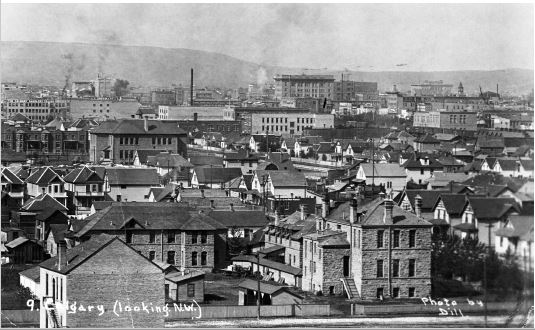 Calgary in 1910 had a population of six thousand, an electric railway, two steel bridges, and an opera house. (Glenbow Archives NA-2267-2)
Calgary in 1910 had a population of six thousand, an electric railway, two steel bridges, and an opera house. (Glenbow Archives NA-2267-2)
In May 1910, John H. Sheppard, his wife, Florence, and their three young children, Jack, Laura, and Florence, emigrated from England. They were the first members of The Church of Jesus Christ of Latter-day Saints to take up permanent residence in Calgary. Charles W. Penrose, president of the British Mission, had advised the family to go to Calgary because they had relatives there. Penrose added that if the Church was not there, it would come to them.[11] The same year, Harold and Rose Christensen and one teenage son moved from Twin Butte to Calgary, followed the next year by their other son, Lyde, and his wife, Sadie. Lyde and Sadie’s son, Harold, was likely the first child born in the Calgary Branch.[12] Other families moved to the area soon afterwards to take advantage of the booming Calgary economy. Some living on farms near Calgary moved into the city during the winters so that their children could attend school.[13]
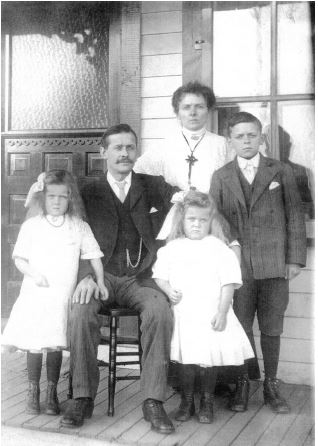 John and Florence Sheppard and their three children were the first LDS family to settle permanently in Calgary, arriving in 1910. (Sheppard family)
John and Florence Sheppard and their three children were the first LDS family to settle permanently in Calgary, arriving in 1910. (Sheppard family)
Growth and Formation of the Calgary Branch
On 10 March 1913, at Eagle Hall, the Calgary Branch was organized as a dependent branch of the Cardston First Ward. Zebulon W. Jacobs, studying law in Calgary, was called as presiding elder.[14] Five families formed the core of the branch: John and Florence Sheppard and their three children, Jack, Laura, and Florence; Jack and Helen Faulkner and their daughter, Nellie; Stephen and Annie Dudley and their children, Markham, Arthur, Mary, Edna, and Pearl; Harold and Rose Christensen with their sons, Irving and Lyde, and Lyde’s wife, Sadie, and son, Harold; Henry Downs, a widower, and children, Mary, Henry, Albert, Ray, Alfred, Izetta, and Leland. The day the new branch was organized, Harold and Rose Christensen had hosted an evening for members and friends at their home. They later reported, “It was a time of rejoicing and spiritual uplift.”[15] The first branch meeting at Nolan’s Hall was held on 30 March 1913. During the next few years, several other men served as presiding elder, including Harold A. Christensen, John H. Sheppard, and Henry Downs.[16]
In the years following the 1912 announcement that a temple would be built in Canada, the overwhelming focus of the Saints and Church leaders in Alberta was on the temple that was to be built. Church members throughout Alberta, including the Calgary Branch, contributed to the fund-raising for and the building of the Cardston Temple. In 1914, Harold A. Christensen, then serving as presiding elder of the Calgary Branch, moved to Cardston to supervise the construction of the temple foundation to ground level.[17]
World War I
On 4 August 1914, Great Britain declared war on Germany. Canada, as part of the British Empire, was also at war. Participation in the war from 1914 to 1918 affected everyone, including members of the LDS branch in Calgary. Farming became very profitable, especially during the first two years of the war, and some members moved from the city back to farms.[18] The Canadian government’s focus on war production elsewhere caused more members to move away. Some men, such as Jack Faulkner, enlisted in the military.[19]
Florence Sheppard Lamb remembered, “During the war years . . . Major Hugh B. Brown was stationed in Calgary for a while and when we heard the clump, clump of boots on the stairway at Nolan’s Hall we knew Hugh B. Brown was coming with his Cardston Regiment, and they had arrived after a Church parade from Sarcee Camp. They were very welcome and swelled our congregation.”[20] The Cardston squadron was in Calgary during the summer and fall of 1915 before being transferred to Medicine Hat in November 1915.[21] But with fewer members, the branch struggled. It could not afford to rent a hall, so the branch met in members’ homes and even stopped meeting for a time.[22]
In 1917, Asael and Maydell Palmer, active members of the Church, moved to Calgary when Asael was hired by the Canadian Pacific Railway to establish a laboratory for soil analysis related to irrigation. They were eager to locate the Church and its members. Soon after their arrival, the Palmers, attending a lecture on the “Social Aspects of Mormonism” by David H. Elton of Lethbridge, discovered thirteen other Church members who had also attended the lecture. The Palmers suggested holding weekly cottage meetings. Henry Downs resumed leadership as presiding elder, and Maydell Palmer taught weekly lessons. Unfortunately for the branch, the Palmers moved in August 1918 to teach at the Knight Academy in Raymond, Alberta.[23] This illustrated one of the challenges for the Calgary Branch: it was transient. Strong members came but did not stay. Even the students attending Normal School went home in May, when their one-year program finished.
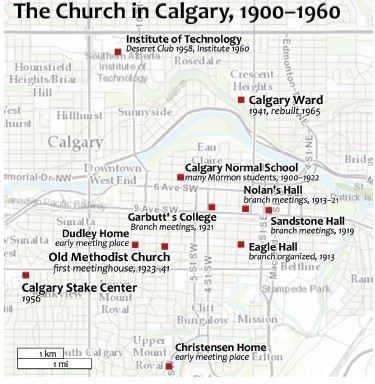 Many meeting places. This map bears witness to the difficulty Church members had in finding and maintaining a suitable location to hold Church meetings during the early years.
Many meeting places. This map bears witness to the difficulty Church members had in finding and maintaining a suitable location to hold Church meetings during the early years.
After the war, men returned home and meetings began again in Sandstone Hall on 8th Avenue and 1st Street East. In 1919, Berg Ellingson arrived in Calgary with his wife, Mary, and six children. Soon after their arrival, both Mary and their newborn son died. Ellingson married Eva Sorensen some fifteen months later. In the meantime, he was called as second counselor in the branch presidency. The branch in 1920 was struggling—not meeting and not unified. Berg was asked to help get things going again. He found a place to meet, Nolan’s Hall, and paid thirty dollars for the first three months’ rent. He recalled, “This small hall could be reached only by a small narrow stairway, and was used by clubs and associations of several sects (mostly drunken) and before we could have Sunday School we had to go and pick up whiskey and beer bottles, cigarette stubs, sweep up, air out straighten it up, etc. Wasn’t that an awful condition? However we stood it and our people were swell. They helped all they could and the Branch was growing so everyone felt encouraged.”[24]
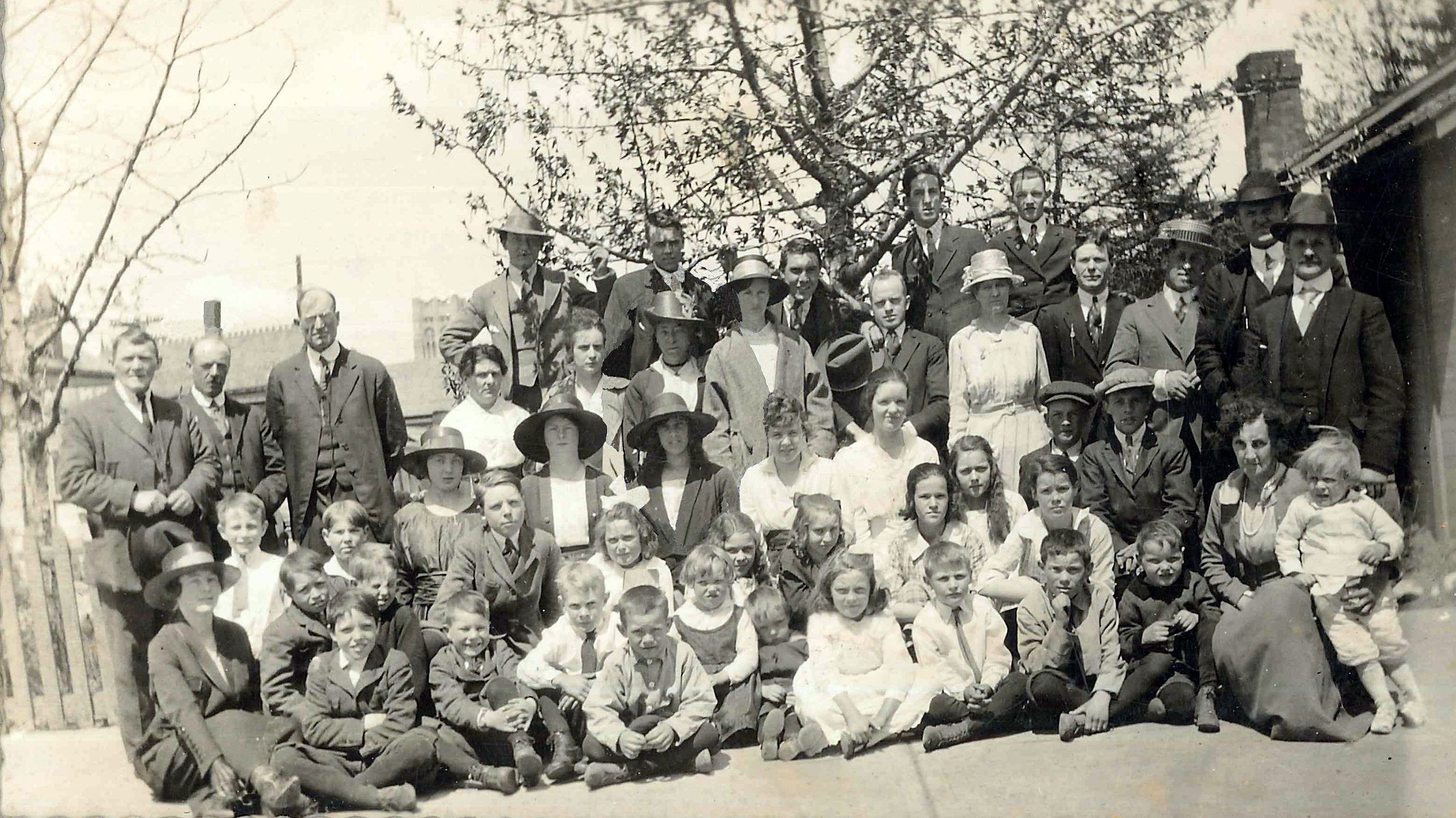 The earliest known photograph of the Calgary Branch was taken about 1920. (Diann Harker)
The earliest known photograph of the Calgary Branch was taken about 1920. (Diann Harker)
In 1921, the Calgary Branch held Sunday meetings at Garbutt Business College. Each room they used held typewriters, numbered tables, and desks, which had to be carried out to the hallways and packed on top of each other to make space to meet. After the meetings, everything had to be replaced in its exact, original place, as the typists noticed if the machines were not in the correct spot. This meant hours of work before and after meetings each Sunday.[25]
On 10 November 1921, Rudger Clawson of the Quorum of the Twelve Apostles organized the Lethbridge Stake, with Hugh B. Brown as president and George W. Green and Asael Palmer as counselors. That same day, Calgary’s first independent branch was organized, with 149 members, as a part of the Lethbridge Stake.[26] On 27 November, Berg Ellingson was sustained as branch president, with John H. Sheppard Sr. and Willard R. Bennett as counselors.[27]
In 1922, the Calgary Branch purchased the old Methodist church at 819 13th Avenue SW for $6,000. The church was run-down, but the Saints fixed, improved, and painted it. The first meeting at their new building was held on 20 May 1923.[28]
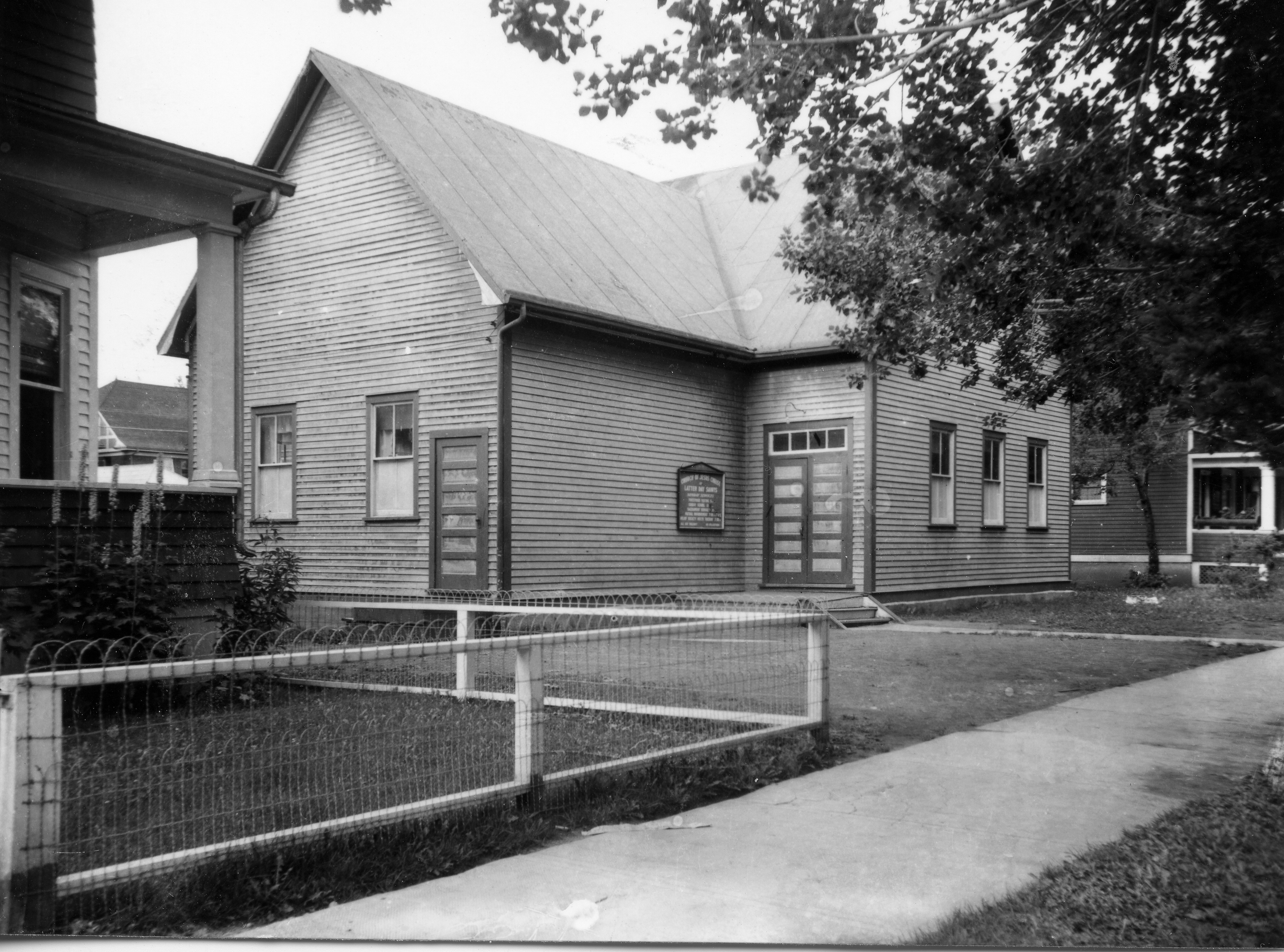 The first meetinghouse of the Calgary Branch, purchased from the Methodists in 1922, required significant effort from Church members to make it suitable for Church meetings. (Rosetti Studios)
The first meetinghouse of the Calgary Branch, purchased from the Methodists in 1922, required significant effort from Church members to make it suitable for Church meetings. (Rosetti Studios)
Women of the Calgary Branch were actively involved in the work of the branch from its inception in 1913.[29] In 1923, Maud Hayes, Relief Society president, in addition to providing spiritual and temporal instruction, encouraged each woman to contribute ten to twenty-five cents per month to charity, to run the Relief Society, and to donate to the branch.[30]
Temple Dedication
The long-awaited Canadian (Cardston) Temple dedication, to the great rejoicing of the Saints in Calgary, took place 26–29 August 1923. Heber J. Grant, President of the Church, and many General Authorities and visitors from Salt Lake were in Cardston for the occasion. The Calgary Albertan newspaper reported that fifty Calgary members attended.[31]
The Calgary Ward
The first ward in Calgary was organized on 12 August 1923, under the direction of Hugh B. Brown and Asael E. Palmer of the Lethbridge Stake presidency. Berg Ellingson, formerly president of the Calgary Branch, became the bishop, with John H. Sheppard Sr. and Arthur Bergson as counselors.[32] Frank Pratt, who attended the organization of the Calgary Ward, remembered, “President Brown spoke very forcibly painting a glowing picture of the future of the church in Calgary.”[33]
Berg Ellingson was ordained a bishop of the new ward on 26 August 1923 by Heber J. Grant, who was in Cardston for the temple dedication.[34] Upon Ellingson’s return to Calgary, the local newspaper reported his calling and ordination as a bishop. His boss, Mr. Moore, after reading the newspaper account, fired him the next day, saying, “This is no place for a Mormon Bishop. You’re canned.”[35] Ellingson, however, found another job and continued as bishop for five years.[36]
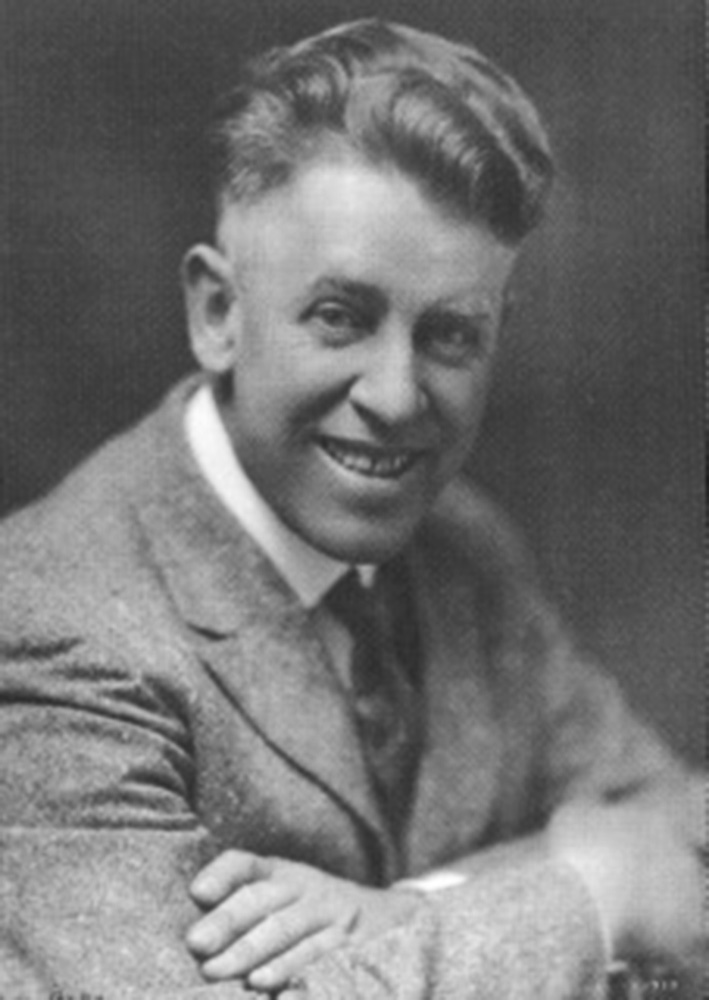 Berg Ellingson, an important early leader, noted for his superb singing voice, served as president of the Calgary Branch (1921–23) and became the first bishop of the Calgary Ward (1923–28). (Michael Clark)
Berg Ellingson, an important early leader, noted for his superb singing voice, served as president of the Calgary Branch (1921–23) and became the first bishop of the Calgary Ward (1923–28). (Michael Clark)
In 1924, the Gleichen Branch was dissolved and remaining members became part of the Calgary Ward.[37] Two missionaries, the first recorded, left from the Calgary Ward in the mid-1920s—Denton Charles Black in 1924 to the Eastern States Mission and Ida A. Obray to the Central States Mission in 1926.[38] On Sunday, 8 January 1928, John H. Sheppard Sr. replaced Berg Ellingson as bishop of the Calgary Ward, with Rutherford B. Hayes and Arthur Bergson as counselors.[39] There were 232 members in the ward and fourteen men held the Melchizedek Priesthood.[40]
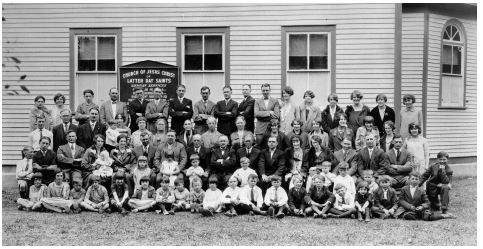 This 1928 photograph of the Calgary Ward, with the renovated chapel as backdrop, shows a considerable increase in membership since the 1920 photograph of the Calgary Branch. (Glenbow Archives NA-3702-12)
This 1928 photograph of the Calgary Ward, with the renovated chapel as backdrop, shows a considerable increase in membership since the 1920 photograph of the Calgary Branch. (Glenbow Archives NA-3702-12)
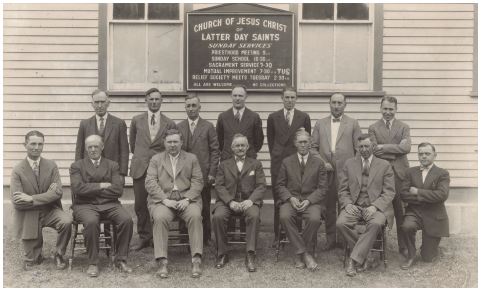 Melchizedek Priesthood holders of the Calgary Ward, 1928. Seated on the front row were members of the bishopric: second from left, John Faulkner, counselor; John Sheppard, fourth from left, bishop; and Arthur Bergson, fifth from left, counselor. (Victor Stockdale and Walter Meyer)
Melchizedek Priesthood holders of the Calgary Ward, 1928. Seated on the front row were members of the bishopric: second from left, John Faulkner, counselor; John Sheppard, fourth from left, bishop; and Arthur Bergson, fifth from left, counselor. (Victor Stockdale and Walter Meyer)
Most of the men of the Calgary Ward in the 1920s were employed in either business or farming and were of modest means.[41] A few families owned their own homes, most of which did not have electricity or indoor plumbing. All families had gardens and grew their own food. Usually they walked to Church because they did not have cars. A few took a streetcar. Several families moved to Calgary during this period, swelling the ranks.[42]
Primary started under the direction of Lucile Ursenbach, Janet Hamilton, Hazel Nelson, and Maud Hayes in 1930 and was held on Saturday at 2:00 p.m. Shirley Sallenbach remembered how much she loved Primary. Her family had to walk to and from Primary, even if it was very cold, as they could not afford bus tickets.[43]
The Great Depression
The Great Depression of 1929–39 was a very challenging time for everyone. Coincidental to the financial crisis was a severe drought lasting many years, which turned the prairies into a dust bowl. In the neighbouring province of Saskatchewan, the provincial income fell by 90 percent, and 66 percent of the population went on “relief.” Alberta was better off but not by much. Technically, all four of the western Canadian provinces were bankrupt from 1932 onwards. By 1935, the province of Alberta was defaulting on interest on its bonds, into which many had invested their life savings.[46]
Church members in the Calgary area were soon engulfed in the challenges of the Depression. In rural areas, the lack of rainfall was devastating. In Frankburg, ninety kilometres southeast of Calgary, where there had been a thriving ward with four hundred members, debt and prolonged drought caused all but three of the families to lose their farms and move away, and the ward had to close.[47] In the city of Calgary, many lost their jobs, and those who retained their employment often had their wages drastically reduced. For example, Charles Ursenbach kept his job, but his salary was cut by 40 percent. So the family took in three boarders to make ends meet. Charles’s wife, Lucile, did the laundry for her family and the boarders with a washboard and soap.[48] Faced with hard times during the Depression, the Tynan family, with three children, fell back on their home resources. Sam was a great gardener, and Verda canned vegetables and fruit and made her own soap, bread, cottage cheese, and butter. She also sewed, embroidered, crocheted, and knitted socks and mittens. They were generous to others who did not have anything and helped a number of the men who were riding west on the trains in search of work.[49]
The Calgary Ward responded to the needs of its members by providing some assistance through fast-offering funds, but it was a serious challenge for Church members to help one another when no one had very much of anything. A few welfare projects were developed to help people in need. In 1939, the Calgary Ward cultivated four and one-half acres of crested wheatgrass as a welfare project.[50]
Church work and growth continued in spite of, or perhaps because of, the challenges of the time. Ward reports from these years mention improvements in the “Mutual Improvement work and activities of the young people.” A very active bishop; repairs, renovations, and refurbishing of the meetinghouse; and a ward temple trip of twenty-one ward members who travelled 470 kilometres round trip to attend the Cardston Temple were important to the ward’s growth. An increase in membership—to 372 by the end of 1932—as well as a slight increase in ward attendance were significant. Tithing numbers were lower, as many had little or no income.[51]
The Relief Society played an important role during this time. One sister, Janet Hamilton Boucher, remembered many challenges during the Depression, noting the influential role of Relief Society women teaching practical skills (such as sewing) and helping those in need. She observed, “It would be difficult to specify a time when more compassionate service was done than during those Depression years.” She added that visiting teaching was a good fellowshipping program because it helped women to be more satisfied with their lot and more determined to help their own families and others who needed help, and not just with “money help.” “I hope that our posterity never have to go through a depression such as the 1930’s,” she wrote, “but if they do, I hope they will have faith sufficient. It is the virtue most necessary to get through depressions without becoming personally depressed. Faith, courage and sufficient energy are all priceless blessings.”[52] Janet Boucher later moved to Toronto, where she was the first stake Relief Society president of the Toronto Stake in 1960.[53]
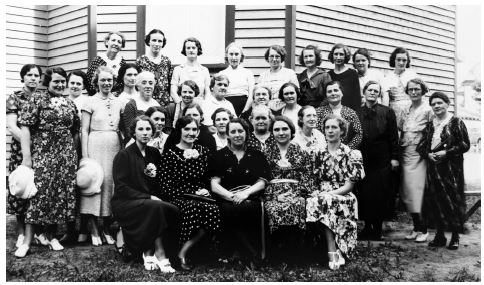 The Calgary Ward Relief Society, shown here in 1936, played a key role in helping its members and their families survive the Great Depression in teaching vital life skills and in assisting one another. (Glenbow Archives NA-3702-19)
The Calgary Ward Relief Society, shown here in 1936, played a key role in helping its members and their families survive the Great Depression in teaching vital life skills and in assisting one another. (Glenbow Archives NA-3702-19)
Church President’s Visit to Calgary in 1936
A signal event in the history of the Calgary Ward was the visit of Heber J. Grant, President of the Church, and his wife, Augusta, to Calgary on 20 August 1936. This first visit of a Church President to Calgary was “much appreciated.”[54] A special meeting was held at noon at the ward meetinghouse, where President Grant spoke about the greatness of Church work and “Faith as a Gift from God.” Fredda Karren Kenney remembered that President Grant said he could “see great possibilities for Calgary,” and that “someday it would become a great city and we were to . . . build a new chapel.”[55]
Several months earlier it had become apparent that the ward could no longer fit in the small church building. A newly formed building committee, which met with President Grant, admitted that they were having serious problems raising funds for a new building because of the poverty of the members. President Grant said, “Brethren I want you to know that the best time to build a building is when your people are poor. It’s easier to build than when people have a lot a money. It will do more good.”[56]
While in Calgary, President Grant also visited the Primary and shook hands with the children present. “I will never forget his shaking my hand. I can actually visualize it as of this very moment,” recalled Morgan Ririe, who was five years old at the time. “As a result of that visit, he always stood out in my mind as one of my childhood heroes.”[57]
Beginning of Fund-Raising at the Calgary Stampede
About 1937, John Sheppard, bishop of the Calgary Ward, asked Charles Obray to operate a small refreshment stand at the Calgary Exhibition and Stampede to raise money for the Church. The next year, the Relief Society started a booth at the Stampede, which ran from Saturday to Saturday. Laverna Ackroyd, the Relief Society president, and her husband, Smith Ackroyd, put up the one hundred dollars needed to build the booth and connect gas and electricity. Men from the ward worked for days to get it ready. Some Relief Society women worked at the Stampede booth; others prepared food or took care of the other sisters’ children while they worked. The booth was operated for three six-hour shifts a day: 8 a.m. to 2 p.m., 2 p.m. to 8 p.m., and 8 p.m. to 2 a.m. Lucile Ursenbach recalled that “the day’s take [was] probably about $200.00 and the dish towels,”[58] which had to be washed for the next day. Janet Boucher reported that the women all had a good time working at the Stampede booth, which required good teamwork and unity.[59]
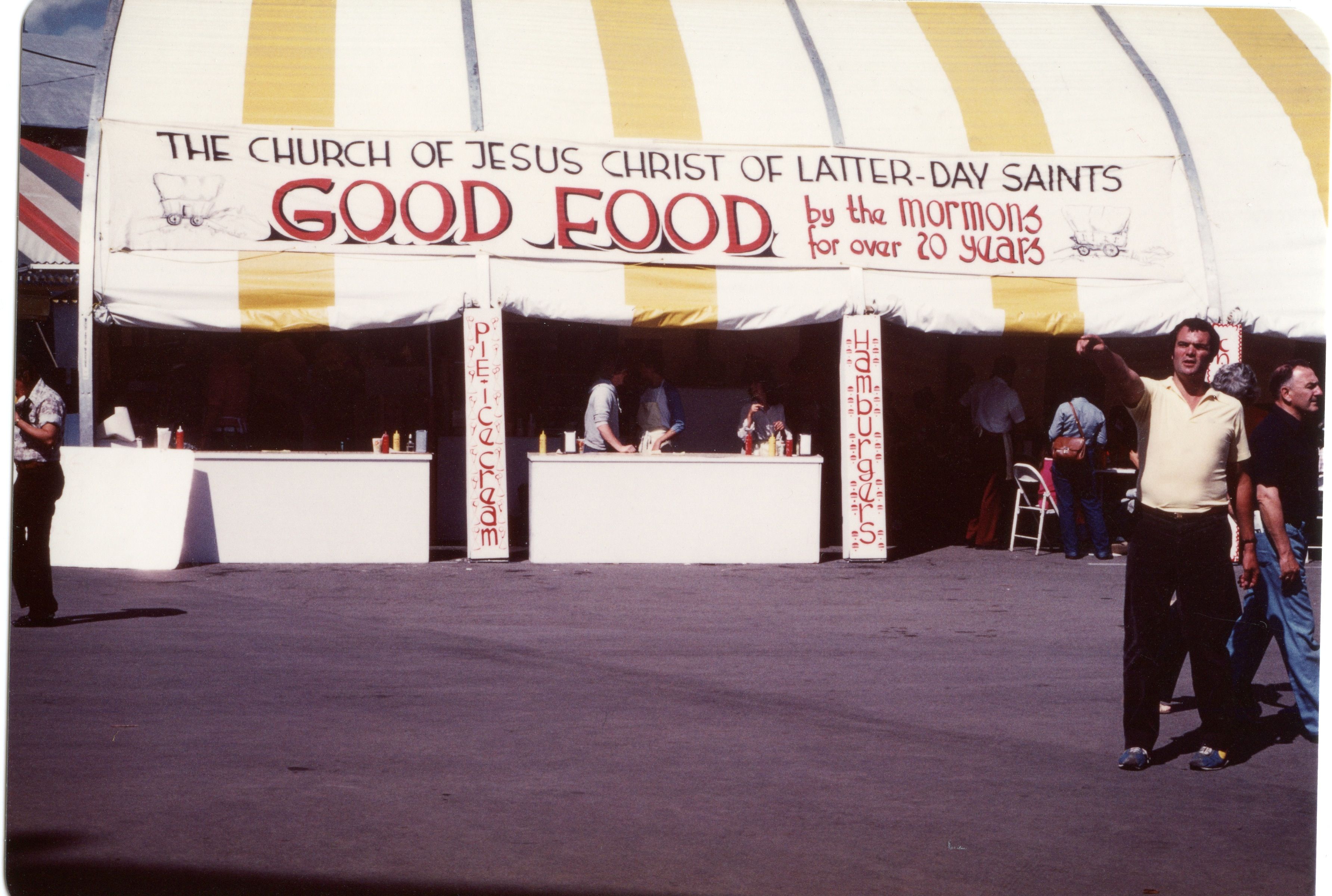 Operating food booths at the Calgary Stampede required a major effort from Church members but served for many years as a major source of funds needed to construct new meetinghouses. (Calgary West Stake)
Operating food booths at the Calgary Stampede required a major effort from Church members but served for many years as a major source of funds needed to construct new meetinghouses. (Calgary West Stake)
This was the beginning of Church fund-raising at the Calgary Stampede. In due course, Latter-day Saints had three large booths, which acquired well-earned reputations for providing excellent food at reasonable prices. The Calgary wards also undertook a major project to provide seating for the Stampede Parade every year. Starting in 1949, the operation grew to include banks of seating a block long and seven metres high. For sixty years, every adult member worked on the Stampede projects, which generated a substantial amount of revenue to finance the construction of new meetinghouses.[60] These projects continued until a change of Church policy ended fund-raising late in the twentieth century.
New Building for the Calgary Ward
Charles Ursenbach, a member of the building committee, found a very choice piece of land for a chapel on the north bluff of the Bow River on Crescent Road and 1st Street NW The site had a panoramic view of downtown Calgary and the mountains in the west and cost $2,500.[61] The ward obtained the title to the land by the end of 1936 and expected the building to cost $40,000. Considering economic events of the time as well as the average age of the ward (most of the congregation were children, and their parents were young and starting out), it was a very ambitious venture.[62]
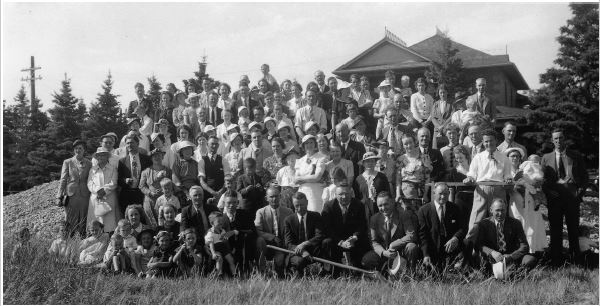 On 18 July 1937, the building site for a new LDS meetinghouse on Crescent Road was dedicated by Asael Palmer, president of the Lethbridge Stake, and the ground was officially broken, preparatory to the beginning of construction the following day. (Calgary West Stake)
On 18 July 1937, the building site for a new LDS meetinghouse on Crescent Road was dedicated by Asael Palmer, president of the Lethbridge Stake, and the ground was officially broken, preparatory to the beginning of construction the following day. (Calgary West Stake)
Church leaders explored various ways the Calgary Ward could meet the required 50 percent share of the cost of the building. Morgan Pitcher, chair of the building committee, proposed finding a contractor who would let the ward buy materials and ward members do most of the labour. The Buchan Construction Company agreed to this arrangement.[63] Ward members also salvaged building materials from the Frankburg Ward meetinghouse. That ward had been discontinued in 1936, when members lost their farms. The Frankburg meetinghouse was dismantled and usable lumber was brought to Calgary for use in the Crescent Road building.[64]
At the Calgary building site, Bert McPhee, a carpenter and ward member, was hired on a monthly basis to work full time and supervise the donated labour.[65] On 19 July 1937, the day after the building site was dedicated, construction began.[66] Charles Ursenbach asked the unemployed members of the ward to work on the meetinghouse during the days and the employed members, during the evenings. A full basement for the building was dug out with picks and shovels, with the help of a team and scraper from Daniel Crapo of Balzac. This saved $752. One member of the branch at that time, Doral Pilling, recalled that “it was fun.” He particularly enjoyed throwing some dirt at Don MacKay, a nonmember who was dating Mary Quist, whom Don later married.[67] Frank Pratt was hired to lay bricks for twenty-five cents per hour. Despite the strenuous work, Church members “donated of their labor and means willingly and cheerfully and worked together with the usual Church co-operative spirit.”[68] The building was closed in before winter.[69]
Remarkably, during this period, leaders noted that ward members paid about 12 percent more tithing than they had during the previous year, in addition to making building-fund donations. Many members were still unemployed and on city and government relief, but they acted in faith.[70] By June 1938, the building was nearing completion. The branch started to hold worship meetings in the new meetinghouse when the building had a rough floor in the cultural hall in order to save money on taxes.[71] Don MacKay, later to become mayor of Calgary, and Mary Quist were the first to be married in the new building; Donald Kenney was the first person to be baptized in the new baptismal font.[72]
Change in Leadership
On 30 January 1939, during a visit to Calgary by Melvin J. Ballard of the Quorum of the Twelve Apostles and Asael Palmer, president of the Lethbridge Stake, Morgan Pitcher was called as bishop of the Calgary Ward, with Charles Ursenbach and Doral Pilling as his counselors. Pitcher replaced John H. Sheppard Sr., who had served faithfully for eleven years in very difficult times.[73] Of his new calling, Morgan Pitcher said, “If I had thought that chairman of the building committee was a big job, I now found that it was nothing compared to the job of a Bishop. It wasn’t long before I had my first funeral and the first wedding, all new experiences to me.” Pitcher also did all the banking and cheque writing. A bit of a shock for modern bishops![74]
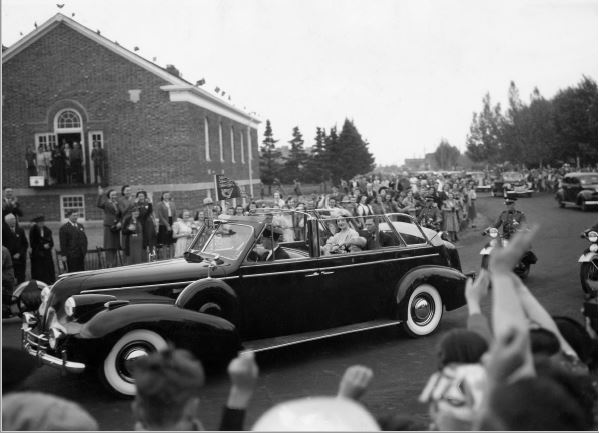 As part of their 1939 North American tour, King George VI, the British monarch, and his wife, the future Queen Elizabeth II, visited Calgary on 26 May. The royal couple is shown here driving past the new Latter-day Saint meetinghouse on Crescent Road. (Calgary West Stake)
As part of their 1939 North American tour, King George VI, the British monarch, and his wife, the future Queen Elizabeth II, visited Calgary on 26 May. The royal couple is shown here driving past the new Latter-day Saint meetinghouse on Crescent Road. (Calgary West Stake)
In June 1940, after the Crescent Road meetinghouse was paid for, David O. McKay, Second Counselor in the First Presidency, came to Calgary to dedicate the new building. Morgan Ririe remembered that the building was totally filled for the dedicatory service. The members’ feeling of pride was universal.[75] The ward continued to add improvements to the building as funds became available. By 1949, as Walter Meyer described, the new structure was “a distinguished and lovely looking building” with an office area, a Relief Society room, classrooms, a hall, a kitchen, and a small baptistry downstairs. The main floor consisted of two larger rooms, the chapel and the cultural hall. The front tower had a cloakroom and library.[76]
Many members who attended church at the Crescent Road chapel had fond memories of the building: reciting an Article of Faith and sitting on the stand in recognition of graduation from Primary; a new deacon passing the sacrament for the first time; and the chorister, Fredda Kenney, who would stop the congregation if she felt they weren’t singing with enough enthusiasm and say, “You must be still asleep. Wake up and sing!”[77]
World War II, 1939–45
The Second World War began for Canadians in September 1939. Calgary was a major training centre, and the Calgary Ward became a home for many servicemen and servicewomen. Some local Church members enlisted in the military. For example, in the fall of 1942, Harold Kearl came to Calgary, joined the Royal Canadian Air Force, and went overseas within the year.[78]
Many adjustments had to be made because of the war. In 1942, the First Presidency asked that visits of Church leaders to outlying branches and wards be limited in light of wartime shortages.[79] During the war, the Relief Society was called on to render more service than usual, providing support to many families whose husbands and fathers were away. The women also made clothing for the war effort, including pyjamas, knitted scarves, mittens, and sweaters for servicemen.[80] In addition to the war’s direct effects, Church activity was affected by a poliomyelitis outbreak in the fall of 1941. All children seventeen and under were not allowed to attend public meetings. That included church![81] Changes in Church leadership also occurred during the war. On 15 November 1942, Charles Ursenbach became bishop of the Calgary Ward, with Doral Pilling and A. Delbert Palmer and, later, Callis Pitcher as counselors. Morgan Pitcher, the former bishop, had moved to Edmonton.[82]
 Morgan Pitcher, bishop of the Calgary Ward, standing in the back row on the left, and members of the ward’s Aaronic Priesthood, 1942. (Glenbow Archives PA-3056-27)
Morgan Pitcher, bishop of the Calgary Ward, standing in the back row on the left, and members of the ward’s Aaronic Priesthood, 1942. (Glenbow Archives PA-3056-27)
Service to Former Enemies
In October and November 1945, after the war had ended, the Calgary Ward, in common with many other LDS congregations, sent food and clothing to the destitute German Saints. Fredda Kenney remembered the Relief Society sisters filling many boxes of clothing and food to send to Germany, so recently their enemy.[83]
Calgary changed significantly after the war. Several events signaled the end of the pioneer era in Calgary, including the passing in 1946 of Florence C. H. Sheppard, who had served faithfully both the Church and her family, and of her husband, John H. Sheppard, an early bishop, who died two years later.[84] On 4 May 1947, under the direction of Elders Ezra Taft Benson and Marion G. Romney, Asael Palmer was released after twenty-one years as Lethbridge Stake president. Octave Ursenbach, who was serving as the president of the Canadian Mission, headquartered in Toronto, was called as the new stake president, with counselors Francis C. Russell and Reid C. Ellison.[85]
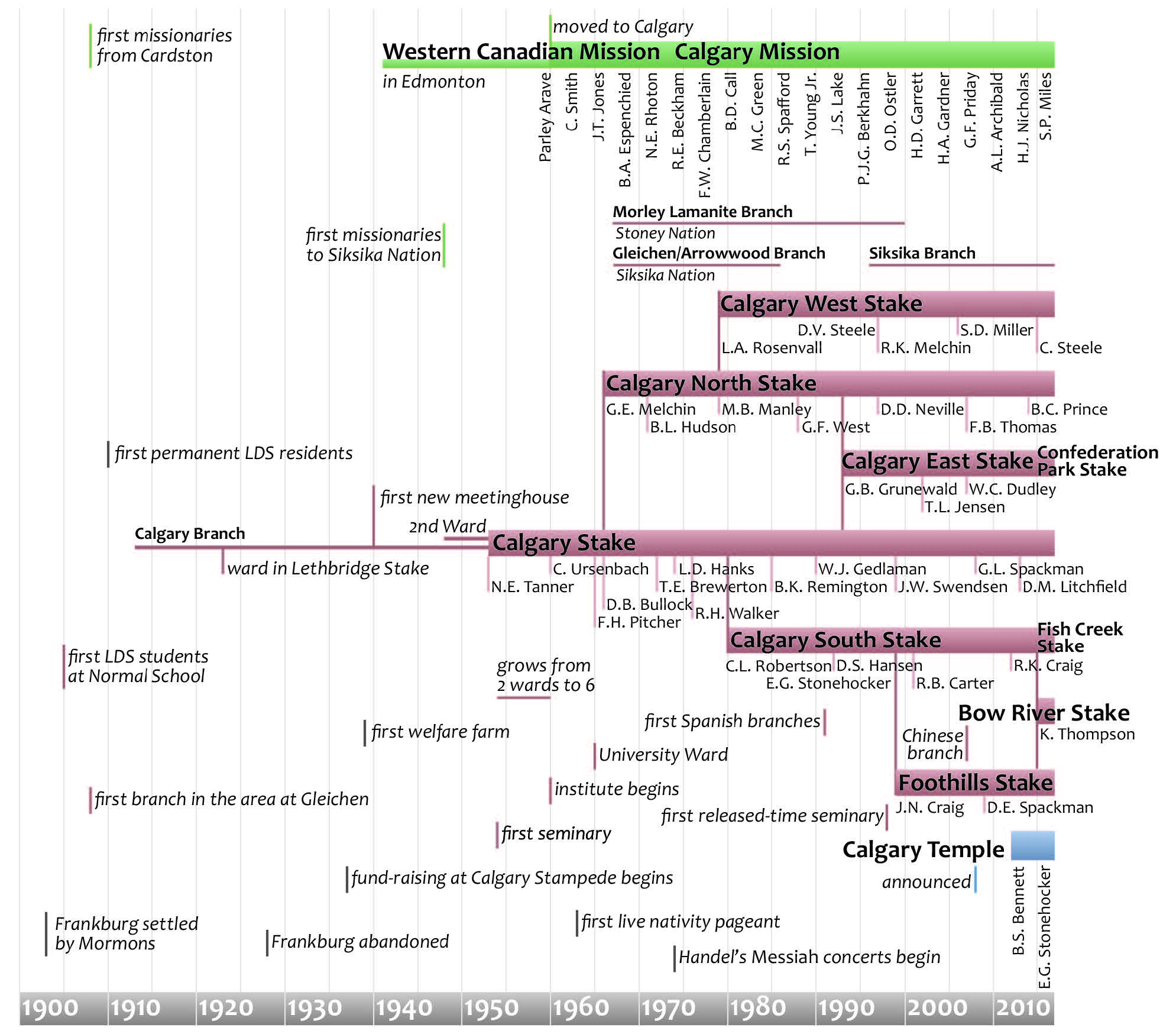
Growth, Growth, and More Growth in the Postwar Era
Being a Mormon in Calgary in the 1950s was exciting. There was a real feeling that the Church and the city were going places. The population of the Church continued to increase, partially due to the expanding oil industry in Alberta. The discovery of the Turner oilfield in 1914 had launched Calgary as an important oil town, which boomed following the discovery of oil in Leduc in 1947. Calgary underwent one of its periodic booms, and the population exploded from one hundred thousand people in 1946 to two hundred fifty thousand in 1956.[86] The focal point of economic opportunity, Calgary drew many Latter-day Saint families and others to seek employment there. Many LDS stayed to marry and raise their families. Many of the newcomers to Calgary possessed excellent leadership and entrepreneurial skills. This resulted in a rich supply of Church leaders.[87] The mayor, Don MacKay, elected in 1949, was a Church member. The Calgary Ward grew to 927 members, and a second ward was formed on 29 August 1948, with Walter H. Pitcher as bishop and Don Kenney and Norris West as counselors.[88] This marked the beginning of a great Church expansion in Calgary that continued well into the twenty-first century.
Missionary work began in earnest in Calgary after the Western Canadian Mission was established in 1941. The mission, with headquarters in Edmonton, originally included only the territory in Alberta north of Calgary. In 1942, the boundaries of the mission were expanded to include Calgary.[89] During the war years, with a limited number of missionaries serving, some converts were made, but after the war, as the ranks of missionaries swelled, the number of converts in the mission increased dramatically.[90] The headquarters of the Western Canadian Mission was moved from Edmonton to Calgary in 1962.[91] After 1962, all missionary work in Alberta was administered from Calgary until the creation of an additional mission, the Canada Edmonton Mission, in 1998.[92]
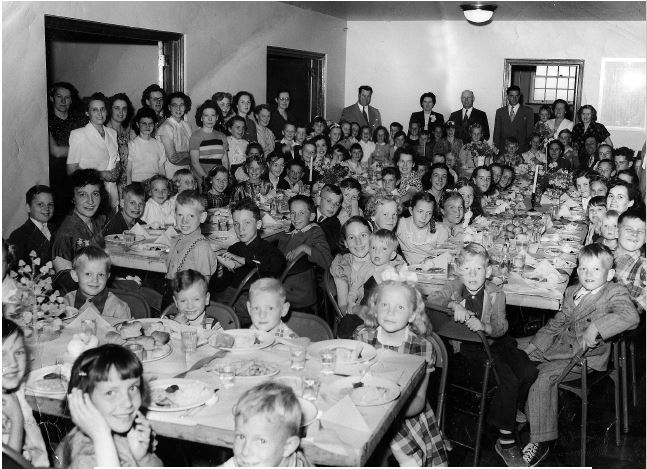 Primary children of the Calgary Second Ward, taken about 1950. (Brian Pratt)
Primary children of the Calgary Second Ward, taken about 1950. (Brian Pratt)
The Calgary Stake
With the rapid increase of Church membership in the Calgary area, the time was ripe for Calgary to assume a greater level of Church administration and responsibility. On 15 November 1953, at a conference in the Palace Theatre in Calgary with the presidencies of the Lethbridge and East Lethbridge Stakes and 1,464 people in attendance, Harold B. Lee and Mark E. Petersen of the Quorum of the Twelve Apostles organized the Calgary Stake. N. Eldon Tanner, a recent arrival in Calgary, was selected as the new stake president, with Charles Ursenbach and Frank H. Pitcher as counselors. The new stake, consisting of 2,474 members, included the two Calgary wards (1,472 members) and six other wards and branches in the surrounding area: Claresholm (219), Rosemary (434), Stavely (70), Red Deer (136), Brooks (67), and High River (76). Five of these wards and branches came from the two Lethbridge stakes (the Lethbridge East Stake being collapsed), and the Red Deer Branch was transferred from the Edmonton District of the Western Canadian Mission.[93] Of the six units of the Calgary Stake outside the city of Calgary, Rosemary and Brooks were in irrigated lands less than 200 kilometres southeast of Calgary; High River, Stavely, and Claresholm were in dry-farming areas within 135 kilometres to the south of Calgary. The city-based Red Deer Branch was nearly 150 kilometres north of Calgary. For the Saints in Calgary, who had for thirty years regularly travelled 220 kilometres to Lethbridge for stake meetings, there was great joy to have a stake of their own.[94]
N. Eldon Tanner, the newly called stake president, expressed gratitude for his calling and for the support of all stake members. He quoted Joshua 24:15, “Choose you this day whom ye will serve; . . . but as for me and my house, we will serve the Lord.” He bore his testimony and concluded the conference by inviting all members to contribute funds for the proposed and much-needed new stake centre.[95]
When Harold B. Lee addressed the newly created stake, he complimented Canada on its observance of the Sabbath day and encouraged the Saints to live the gospel perfectly and be united in the faith. The purpose of the stake formation, he said, was to have a more complete Church program. Lee expressed his expectation that the Calgary Stake would be a leader and that all the members would support their new stake presidency. He counselled the Saints that the greatest security is in keeping God’s commandments, for “I, the Lord, am bound when ye do what I say; but when ye do not what I say, ye have no promise.”[96]
The Calgary Stake Centre
The greatest need in the new stake was another building—a stake centre. Wards were meeting in schools and in other locations, including a Seventh-day Adventist chapel. On 18 January 1954, President Tanner received approval from the Presiding Bishopric in Salt Lake City to proceed.[98] The site desired, located on 17th Avenue SW, was purchased for $6,000, and it was estimated that the meetinghouse would cost about $400,000 to build. Raising the stake’s share of the cost of 50 percent was a significant challenge. Stake leaders arranged with contractors, as had been done for the Crescent Road meetinghouse in the 1930s, for Church members to subcontract back some of the work to raise money.[99] Officers of the new Calgary Stake included Fredda Kenny, stake Relief Society president; Mary Platt, stake Primary president; Ruth Dolan, Young Women’s MIA president; Callis H. Pitcher, Young Men’s MIA president; and Harold Kearl, Sunday School superintendent. The new stake was a large one, and every month, stake leaders travelled hundreds of kilometres to all of the wards and branches, from Claresholm in the south, to Brooks and Rosemary in the east, to Red Deer in the north.
 Stake President N. Eldon Tanner turns the first shovelfull of earth for the new stake centre on 17th Avenue SW on 117 April 1955. (Ferd Meyer)
Stake President N. Eldon Tanner turns the first shovelfull of earth for the new stake centre on 17th Avenue SW on 117 April 1955. (Ferd Meyer)
In addition, many other fund-raising projects were undertaken by all organizations of the stake and by individual members. The Primary contributed $100 from a shoe sale and $500 from a contest sponsored by a toothpaste company; the Relief Society contributed $400 from a square dance; the YMMIA, $200 from a dance; and there were many more projects and fund-raising activities.[100] Relief Societies put on many bazaars, selling quilts and other items made by sisters. Hundreds of boxes of homemade chocolates were made and sold.[101] Food concessions at the Calgary Stampede were operated every year. These were huge undertakings. Fund-raising projects were crucial to the Calgary Saints being able to build new churches.
From the 1930s through to the 1990s, it was necessary for Church members to contribute to building funds to provide buildings and their maintenance, and to ward budgets to meet the costs of wards and stake programs. There were also welfare assessments. Families were assessed amounts to contribute, and many struggled to make these donations. Harold Kearl noted that the widows were especially willing to give to the building cause.[102] The principle of sacrifice, however, brought many blessings.
The groundbreaking for the Calgary Stake Centre was held on 17 April 1955. This property, like the Crescent Road building, was also a choice piece of land with a great view north. The building was completed in less than eighteen months.
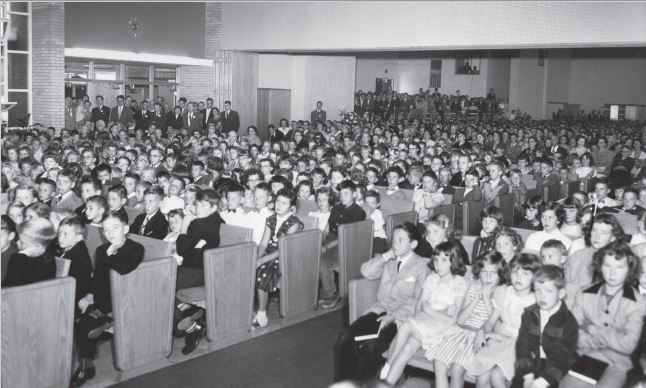 When the stake centre of the Calgary Stake was dedicated in 1956 by Church President David O. McKay, the chapel, at his request, was entirely filled with children. Adults sat in the cultural hall. (Church History Library, hereafter CHL)
When the stake centre of the Calgary Stake was dedicated in 1956 by Church President David O. McKay, the chapel, at his request, was entirely filled with children. Adults sat in the cultural hall. (Church History Library, hereafter CHL)
The Calgary Stake Centre was dedicated on 16 September 1956. President David O. McKay agreed to dedicate the Calgary Stake Centre on two conditions: first, that the chapel in the first session be filled with just children; and second, that the building be entirely paid for. At the morning dedicatory session, over 2,258 people attended. The meeting was directed to the children. President McKay asked the children what this or that part of their body was worth. He told the children that they were millionaires. Charles Ursenbach, president of the stake, said that it was a “thrilling meeting.” At the end, President and Sister McKay stood and shook hands with each of the 510 children in the chapel that day. About 2,600 people attended the dedicatory session in the afternoon.
This heralded a great expansion of the Church in Calgary. By 1956, there were four Calgary wards meeting in the new stake centre. The Calgary 5th Ward was formed in 1959 and the 6th Ward on 10 January 1960. Meeting space was at a premium. Growth also occurred in units of the stake that were outside the city. Meetinghouses were dedicated in Claresholm (1957) and Rosemary (1958). In 1960, the Brooks Branch and the Rosemary Ward were reassigned to the Taber Stake, and the Claresholm and Stavely Wards, to the Lethbridge Stake.[103]
N. Eldon Tanner was president of the Calgary Stake for seven years. His themes were unity and harmony, which he preached and lived. He challenged many people to change their way of living, to commit to living the gospel. He invited less-active Church members to accept callings and assignments and improve their lives. Beth Tanner Spackman said her father had faith in the people and loved them. They grew “in faith in themselves and God.”[104] Stake membership rose to 3,566 people, an increase of over 40 percent during his presidency. Under Tanner’s leadership, the Calgary Stake became a top-performing stake in the Church. First, the stake rose to the top ten in the Presiding Bishopric office’s ranking of stakes. Then in February 1960, the Calgary Stake was number one. President Tanner was asked, “Are you satisfied?” He replied, “Yes, I’m satisfied we can do it. Let’s keep on doing it.” And they maintained that position for eleven months.[105]
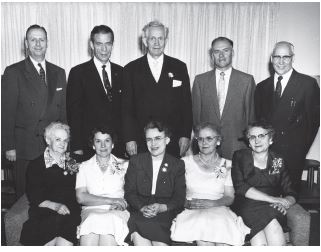 The Calgary Stake presidency with Church President David O. McKay and their wives on the occasion of the dedication of the stake centre in 1956. Back, left to right: Frank Pitcher, N. Eldon Tanner, David O. McKay, Donald Kenney, Charles Ursenbach; front, left to right: Emma Ray McKay, Fredda Kenney, Caroline Pitcher, Sara Tanner, Lucile Ursenbach. (CHL)
The Calgary Stake presidency with Church President David O. McKay and their wives on the occasion of the dedication of the stake centre in 1956. Back, left to right: Frank Pitcher, N. Eldon Tanner, David O. McKay, Donald Kenney, Charles Ursenbach; front, left to right: Emma Ray McKay, Fredda Kenney, Caroline Pitcher, Sara Tanner, Lucile Ursenbach. (CHL)
On 8 October 1960, N. Eldon Tanner was called as a General Authority of the Church, an Assistant to the Twelve, resulting in his relocation to Salt Lake City. The following month, Tanner returned to Calgary with Richard L. Evans of the Quorum of Twelve Apostles to install a new stake president. Charles Ursenbach was called and sustained as president of the Calgary Stake on 16 November 1960. Of his heavy, new responsibility, Ursenbach recalled, “That came as a great shock and I could hardly speak.”[106]
Accelerated Construction of Meetinghouses
An intense building program was undertaken in Calgary Stake, as more meetinghouses were needed to accommodate the burgeoning Church population. In 1964, the Crescent Road building, built at great sacrifice in the 1930s but no longer adequate to meet the needs of the growing membership, was demolished to make way for a modern, full-sized building, which was dedicated in 1965.[108] Church buildings were also dedicated in Red Deer (1964), High River (1965), and two more in Calgary: Glenmore (1964) and Bow Valley (1965).[109] The genealogical library, originally established in 1952 in the Crescent Road meetinghouse, was moved to the stake centre in 1965 with better facilities and continues to operate there.[110]
Seminary and Institute
Forty youth began attending seminary in 1954 in the Crescent Road chapel.[111] Seminary, either early morning or home study, has been widely attended in all the Calgary stakes. In the 1990s, released-time seminary was arranged in conjunction with Lord Beaverbrook High School. A house across the street from the school was purchased and later remodeled so that high school students could attend seminary classes in conjunction with their other courses. Similar arrangements have been made at other high schools, such as the new Centennial High School in 2004.[112]
Efforts were made to meet the needs of college and university students. In 1958, the LDS Deseret Club was organized on the University of Alberta campus in Calgary. The group operated off and on until an institute program began in 1960.[113] In March 1965, University Ward was organized for those attending college and university, and an institute building across from the University of Calgary was completed for the ward in 1968.[114] Tenth Branch for single adults was created on 11 December 1974 and made a ward in 1978. Calgary became a magnet for Latter-day Saint young singles from across Canada who sought association with a larger Mormon peer group.[115] On 14 February 1993, Tenth Ward was discontinued, and the same day, each stake in Calgary created its own young single adult ward. In the Calgary Stake, it was called the Edworthy Park Ward.
First Nations and the Church
While Calgary does not have a large component of First Nations people, three First Nations reserves are close to Calgary: the Siksika, the Tsuu T’ina, and the Stoney Nakoda reserves. There is an LDS presence in all three reserves, most notably in the Siksika reserve near Gleichen.
Two missionary couples from Rosemary, Charles and Lillie Norton and Byron and Jennie Vance, were the first to proselytize on the Siksika reserve in 1948. The couples would travel to Gleichen and spend the day on the reserve visiting people and talking about the Book of Mormon. The first person from the Siksika Nation to join the Church was Annie Manyheads. Other missionaries, including those who taught Francis Crowfoot and other members of the Crowfoot family in the 1950s, built on the work of the Nortons and Vances. Some First Nations people who joined the Church at that time were Tom and Lily Healey, Joe and Maggie Crowfoot, and Harry Goodeagle. Spencer W. Kimball, while still an Apostle, visited the reserve and held a meeting with members there. In the late 1970s, the reserve was dedicated and the Arrowwood Branch formed. After the Arrowwood Branch was dissolved in 1986, Siksika members attended the Strathmore Ward.[116] The reserve was rededicated in 1993, and the Siksika Branch was formed on 21 July 1996. Their meetinghouse in Gleichen was dedicated in 2002.
The Tsuu T’ina reserve lies on the southwest border of Calgary, and Church members came primarily from the Crane family, who for many years attended the Woodbine Ward. In the northwest is the Stoney Nakoda reserve. There was a branch in Morley, but it was dissolved.
First Nations Church members in the Calgary area have engaged in numerous memorable trips and events. Over the years, a number of annual gatherings of First Nations members were held in Calgary. A group of eighty First Nations Church members from the Calgary area participated in a temple trip, and fifty-seven made a trip to general conference in 2001. First Nations Latter-day Saints from Calgary and from other reserves in southern Alberta also participated in a special conference in Montana in 1996.[117]
A Second Stake
By 1966, membership of the Calgary Stake had risen to six thousand. The division of the Calgary Stake and formation of the Calgary North Stake took place on 17 April 1966, under the direction of Spencer W. Kimball of the Quorum of Twelve Apostles and A. Theodore Tuttle of the Seventy. Essentially, the Calgary North Stake was north of the Bow River while the Calgary Stake was south. D. Bruce Bullock was called as president of the Calgary Stake, which had six wards: First, Fourth, Fifth, Glenmore, and Willow Park, with High River outside the city of Calgary. Gerald Melchin was the president of the new Calgary North Stake. The new stake consisted of five wards: Second, Third, Sixth, Bow Valley, and University, and three branches—Olds, Drumheller, and Banff—which were reassigned from the Western Canadian Mission. The Calgary North Stake centre was dedicated on 29 October 1972[118] along with other meeting houses, in Olds (1971) and Banff (1972).[119]
Welfare Production
Welfare projects, in which Church members worked together to produce food and other necessities for the benefit of the needy, were developed as early as 1933. A soap factory on Macleod Trail was operated in the late 1940s.[120] The Calgary Stake purchased three-quarters of a section of land twenty-one kilometres east of Calgary. In May 1964, a farm of 2,380 acres on the Little Bow Creek thirteen kilometres east of Cayley was purchased at a cost of nearly $250,000, and the previous farm was sold.[121] Members worked together to pick rocks, build fences, paint, and harvest crops. Later, with the creation of the Calgary North Stake, the Cayley farm was sold, and two farms were purchased in Strathmore and Carsland. With changes in direction, the Strathmore farm was sold. Over the years, most stakes had farms. Farms were supervised by a high councilor and had a manager living on the farm.[122]
Solemn Assembly, 1975
Church President Spencer W. Kimball came to Calgary on 2 August 1975, along with his counselors, N. Eldon Tanner and Marion G. Romney, and other General Authorities to hold a solemn assembly. Seven hundred Primary children stood on the lawn of the Calgary North Stake Centre on Tipton Road, singing “I am a Child of God” as the prophet arrived. President Kimball spoke with the children before proceeding into the building. About a thousand priesthood holders from Alberta attended the meeting, where they partook of the sacrament and listened to instruction from the prophet and other visiting Church leaders. The purpose of the solemn assembly, President Kimball explained, was to strengthen priesthood leaders and to discuss with them “doctrinal and spiritual matters in a direct way.”[123] His own address focused on marriage and the importance of husbands and wives as equal partners, treating one another with kindness and mutual respect. While in Calgary, President Kimball also spoke to five hundred youth at a fireside.[124]
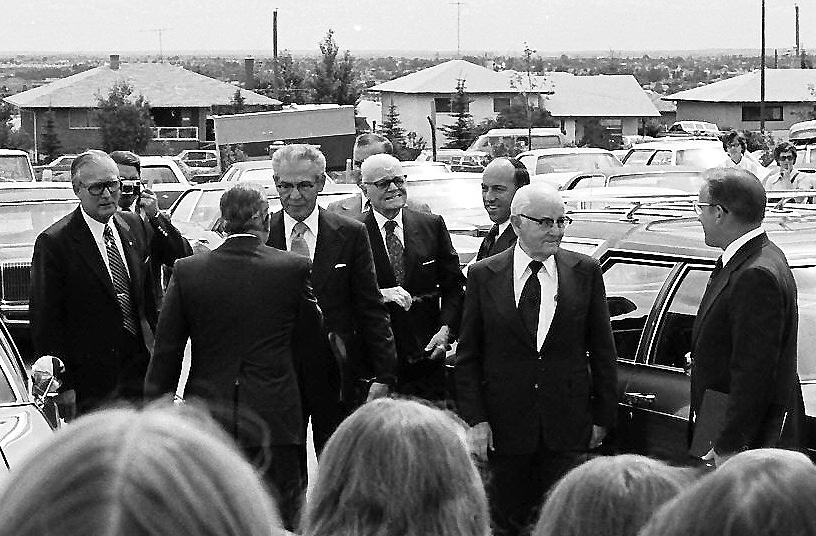 The First Presidency—Spencer W. Kimball, N. Eldon Tanner, and Marion G. Romney—arriving in Calgary in 1975 for the solemn assembly. (Walter Meyer)
The First Presidency—Spencer W. Kimball, N. Eldon Tanner, and Marion G. Romney—arriving in Calgary in 1975 for the solemn assembly. (Walter Meyer)
Continued Growth—From Two to Seven Stakes
The Church of Jesus Christ of Latter-day Saints continued to grow in the Calgary region. From 1953 to 2015, approximately one new ward was formed in Calgary each year. One example of the Church’s growth is illustrated by fact that the original area of the Parkland Ward had become twelve wards by 2015.[125]
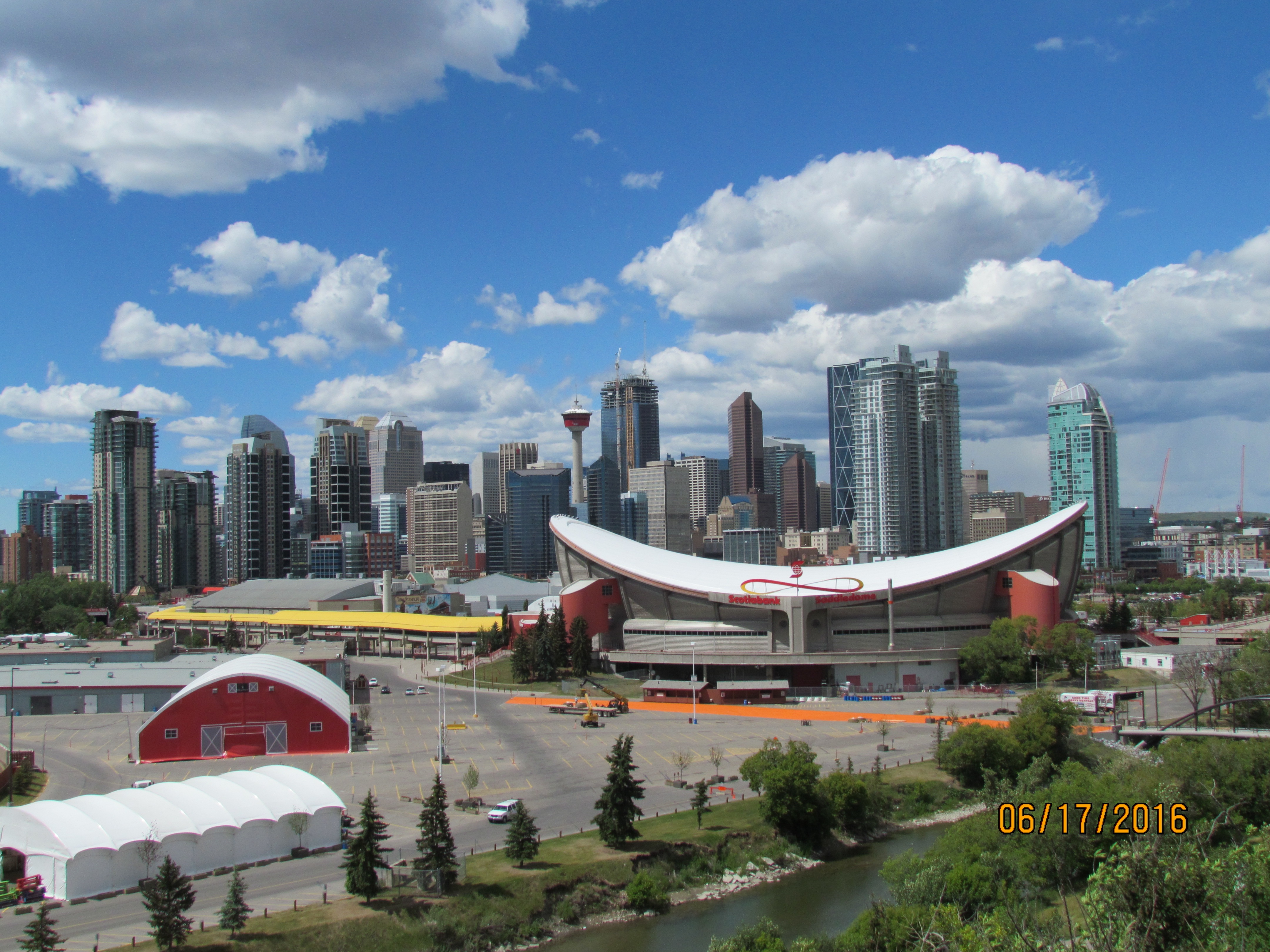 As Calgary became the centre of the booming oil industry, the city’s population mushroomed and high-rise buildings appeared. As the corporate headquarters of many Canadian corporations, Calgary was attractive to many young Latter-day Saint families. This photograph, taken in June 2016, shows in the foreground the Saddledome, built for the 1988 Winter Olympics. (Linda Davis)
As Calgary became the centre of the booming oil industry, the city’s population mushroomed and high-rise buildings appeared. As the corporate headquarters of many Canadian corporations, Calgary was attractive to many young Latter-day Saint families. This photograph, taken in June 2016, shows in the foreground the Saddledome, built for the 1988 Winter Olympics. (Linda Davis)
Five additional stakes were created in the Calgary area between 1979 and 2015. The Calgary West Stake was formed in 1979, with Lynn Rosenvall as its first president. When the Calgary South Stake was formed in 1980, C. L. (Dil) Robertson was appointed stake president. In 1993, the Calgary East Stake was organized, with Geoffrey B. Grunewald as president. John N. Craig was chosen as president of the Foothills Stake, which was formed in 1999. The Church in Calgary continued to grow and flourish. In December 2015, several stakes were realigned and renamed, and the Calgary Bow River Stake, a seventh stake, was organized, with Kevin C. Thompson as president.[126] (See map at beginning of chapter.) In 2016, a new ward (the Legacy Ward) was created in the Calgary Fish Creek Stake, and a branch was added to the existing ward in High River in the Calgary Alberta Foothills Stake.[127]
To accommodate the expanding Church membership, a vigorous building program was required. New stake centres were constructed, including that of the West Stake in 1982, the East Stake in 1997, and the Foothills Stake in 2003. A multitude of other meetinghouses were constructed in Calgary and the surrounding areas, including Olds (1971); Banff (1972 and redone in 1986); Forest Lawn (1975); Willow Park (1977); Parkland (1978); Coach Hill (1986); Martindale (1986); Strathmore (1989); 24th Street SW (1990); Airdrie chapel (1991); Woodgate Road, Okotoks (1993); Sundance (1994); Calgary Panorama (2005); Royal Oak (2005); Cochrane (2005); Drumheller chapel major addition (2007); Bannister Drive, Okotoks (2009); Diamond Valley in the Turner Valley (2008); and Reunion chapel, Airdrie (2009). As the towns of Airdrie and Okotoks became bedroom communities for Calgary in the 1990s, many young couples chose to settle down and raise their families in these smaller, less expensive towns. Wards were created, and by 2015, there were five wards in Airdrie and four in Okotoks, with two meetinghouses in each town.
When the original Calgary Stake was formed in 1953, it included two wards in Calgary and four wards and two branches outside the city. In 2015, after more than sixty years of growth, the same pattern prevailed. The seven Calgary stakes, in addition to numerous wards within the city, also had many wards and branches beyond the boundaries of Calgary, where the Church also had been growing over the years. In addition to the Airdrie and Okotoks Wards mentioned previously, the outlying units included the Banff Branch, Chestermere Ward, Cochrane Ward, Diamond Valley Branch in Turner Valley, Drumheller Branch, High River Ward, Siksika Branch in Gleichen, Strathmore Ward, and a new branch in High River in 2016.[128] In 2015, the Calgary North and Calgary Foothills Stakes consisted almost equally of wards in Calgary and units outside the city.
Regional Conferences and Then Satellite
A Calgary regional conference was held 13 May 1984. All five Calgary stakes met together in the Calgary Saddledome to hear Ezra T. Benson, President of the Quorum of the Twelve Apostles, and other Apostles. Five years later, on 27 August 1989, a second Calgary regional conference was held with Russell M. Nelson of the Quorum of the Twelve. Elder Thomas Monson of the Quorum of the Twelve attended a third regional conference held in mid-September 1998 in the Jack Simpson Hall on the University of Calgary campus. Later President Hinckley spoke at the Saddledome.[129]
With the advent of satellite technology, a new way for the Church leaders to connect with members was inaugurated. Members watched the dedications of the Palmyra (2000), Winter Quarters (2001), and Nauvoo (2002) Temples. Special events such as the dedication of the Calgary Temple broadcast within Alberta in 2012 and the rededication of the Montreal Temple broadcast to congregations across Canada in 2015. In 2005, Thomas S. Monson of the First Presidency presided over the first Canada-wide joint stake conference, broadcast live from the new Calgary Foothills Stake Centre to LDS meetinghouses across the country. Approximately every two years thereafter a broadcast has offered to Calgary Saints the opportunity to hear from Church leaders.
Multiculturalism
Canada has long been welcoming to immigrants, but for many years, most of these newcomers came from the United States, the British Isles, and Europe. Changes in immigration policies in the late 1960s resulted in more people coming to Canada from Asia, Africa, Latin America, and the Caribbean. In 1971, for the first time, a majority of immigrants to Canada were of non-European ancestry, and visible minorities continue to constitute a high proportion of new Canadians. Calgary has benefitted from the arrival of Latter-day Saints from many parts of the world, and this is reflected in the varied ethnic compositions of many wards and branches. In addition, language units have been established. The Forest Lawn and Heritage Branches were organized for Spanish-speaking Church members in 1991. These two branches were combined in 1999 to form the Crescent View Ward.[130] In 2009, the Elbow River Branch was created for Spanish-speaking members.[131] In 2005, two Mandarin groups were created as part of existing wards, one in the north of the city and one in the south. In 2015, there was one Mandarin unit in Calgary, the Bow River Branch. In 2013, a Korean group was organized.[132] The growing ethnic diversity of Calgary has added depth and richness to the Church culture. With widely different backgrounds and cultures, members have sometimes been challenged in their ability to understand and work with one another, but their testimonies of the truths of the Restoration and their commitment to living the gospel helped all to grow together in love and unity.
Calgary has also continued to grow as a city. In 2006, the city achieved the population milestone of one million and in 2015 was about 1.5 million.[133] By the end of 2015, Church membership in the seven Calgary stakes, which included the city and surrounding areas, had grown to 21,387.[134]
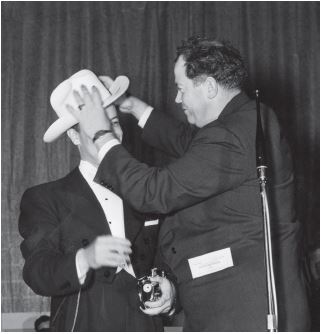 LDS Mayor Don MacKay presenting a white Stetson to a dignitary. Mayor MacKay inaugurated the white hat tradition in Calgary, which has continued into the twenty-first century. (Glenbow Archives PA-3719-10)
LDS Mayor Don MacKay presenting a white Stetson to a dignitary. Mayor MacKay inaugurated the white hat tradition in Calgary, which has continued into the twenty-first century. (Glenbow Archives PA-3719-10)
Calgary Traditions
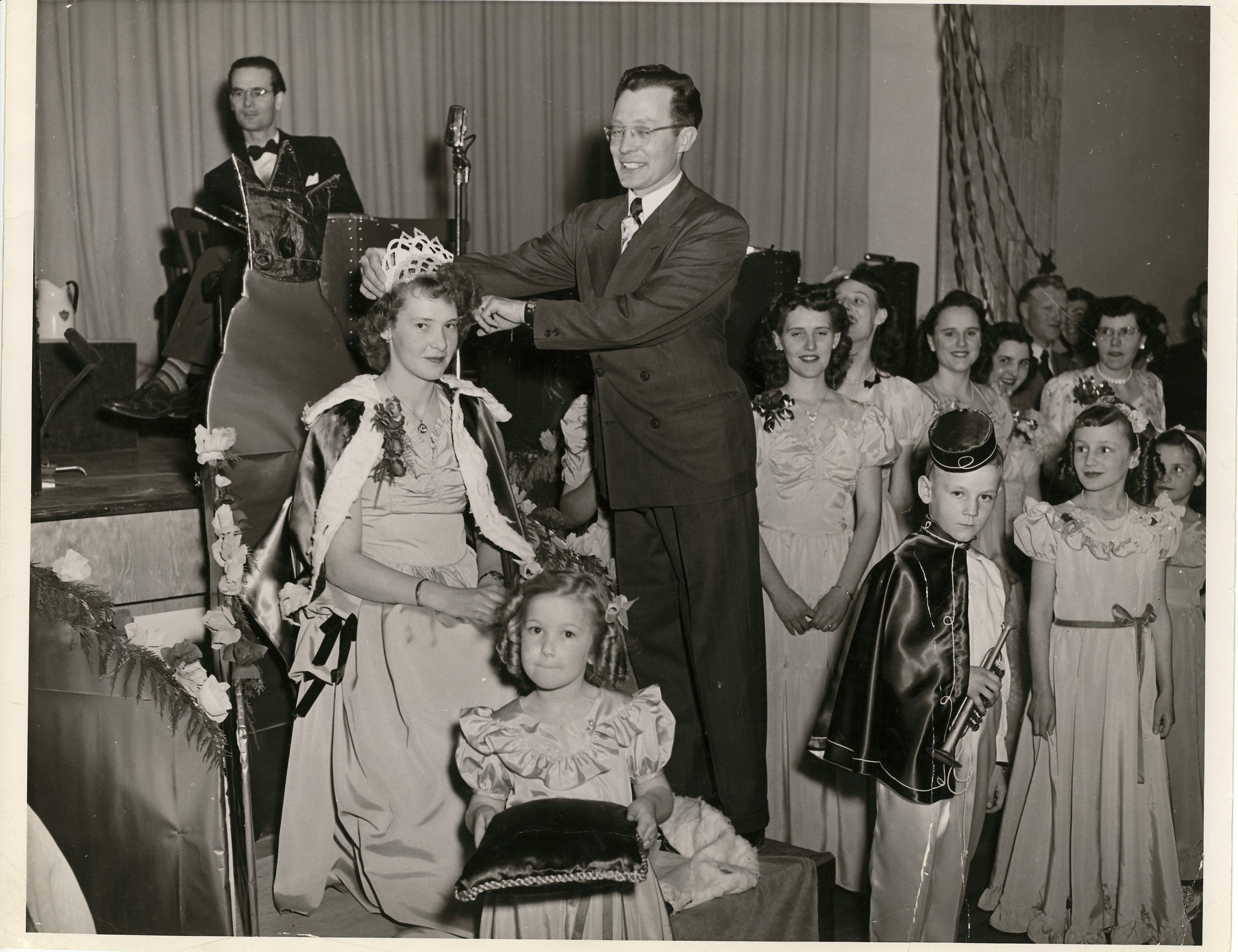 Gold and green balls were held annually in the Calgary wards and were popular Church social activities. This photo shows the 1950 crowning of the gold and green ball queen, Hellen Martin (Davis), by Norris West, a counselor in the bishopric. (Hellen Martin Davis)
Gold and green balls were held annually in the Calgary wards and were popular Church social activities. This photo shows the 1950 crowning of the gold and green ball queen, Hellen Martin (Davis), by Norris West, a counselor in the bishopric. (Hellen Martin Davis)
Saturday Night Dances
The early Calgary units held dances as well as gold and green balls. Saturday-night dances began in the late 1950s when Robert H. Walker and Jack Armstrong decided it would be good for Latter-day Saint youth to have a wholesome place to gather on Saturday nights. Dances were usually held at 17th Avenue SW stake centre and served all the LDS youth, fourteen years of age and up, in the region. Young single adults from the Calgary area, including those in the six YSA wards, were enthusiastic supporters of the weekly dances, which became well known to young singles across Canada. This weekly tradition continued until 2006, when costs and changes in Church policy caused the dances to become monthly. Many young people found their future spouses at these dances, and many nonmembers attended with their Mormon friends.[137] In 1980, the four Calgary Stakes held a combined social event, “A Time to Dance,” at the Stampede Corral.[138]
Scouting
Scouting has played an important role with young men in Calgary, and many have become Queen’s Scouts.[139] In 1981, the Fifth Canadian Scout Jamboree, attended by nineteen thousand, was held in a wilderness area in Kananaskis Country, 128 kilometres west of Calgary.[140] Approximately one thousand LDS Scouts participated in challenging hikes, games, and scoutcraft activities and met in 110 priesthood and sacrament meetings at various locations on Sunday.[141] The Fifteenth World Scout Jamboree hosted by Scouts Canada was held in the same location in 1983, in which LDS Scouts in Calgary also participated.[142]
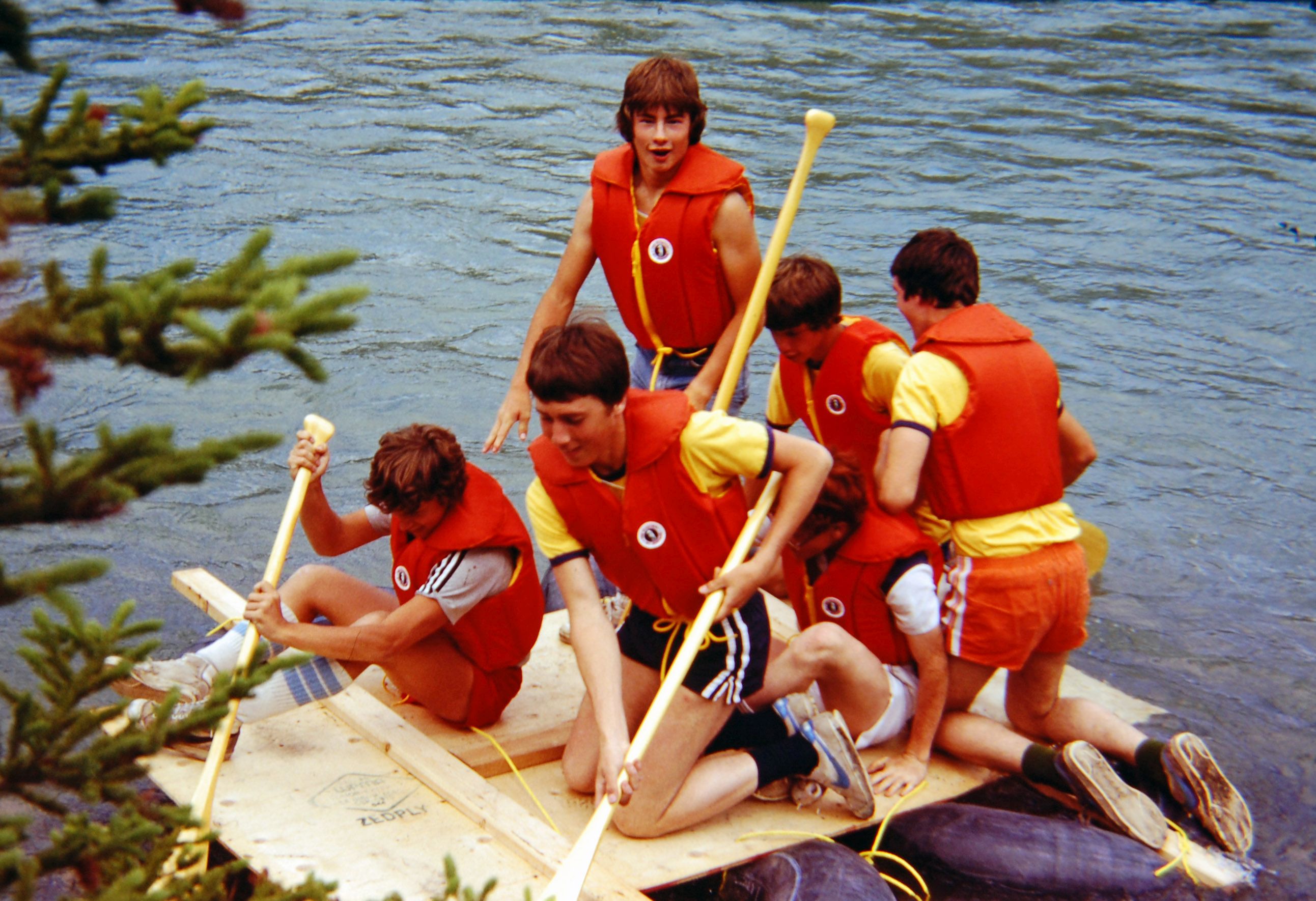 Scouting activities provided not only leadership and skills training but also challenges and fun for LDS young men in Calgary. Pictured here are five Venturers of the Bow Valley Ward, Calgary West Stake, and one visitor, attempting to launch a homemade raft in a competition at the 1981 Canadian Scouting Jamboree. (Wayne Nysetvold)
Scouting activities provided not only leadership and skills training but also challenges and fun for LDS young men in Calgary. Pictured here are five Venturers of the Bow Valley Ward, Calgary West Stake, and one visitor, attempting to launch a homemade raft in a competition at the 1981 Canadian Scouting Jamboree. (Wayne Nysetvold)
Treks
From 1992 to 1997, the Calgary North Stake youth were involved in a number of pioneer treks. Gordon West, a former stake president, identified these treks as some of the most memorable events of his service in the Church and termed them a “smashing success.” There was rain, mud, cold, and sunny weather as they trekked in a mountain location. West recalled, “The Lord had a hand in a natural way and tested our endurance which helped everyone emphasize possible hardships the saints must have gone through. It certainly provided a humbling effect on all of us.”[143] Other stakes have sponsored similar activities, such as Moroni’s Quest, the Joseph Smith Encampment, West to Zion, Helaman’s Encampment, and many more.
Family History
The first genealogical library in Calgary was opened in 1952 in the Crescent Road meetinghouse. Bert Litchfield, an avid genealogist, was the librarian and the key figure behind genealogical and family history research for many years in Calgary. In 1965, the library was moved to the Calgary Stake centre and opened to the public as well as to Church members. The name-extraction programs operated in Calgary stakes as early as the late 1970s. In 2015, each stake in Calgary had a family history centre.[144]
Choirs and Musicals
Music has long been an important element among Church members in Calgary. Ward choirs have been the norm in every ward. In the earliest years, the Singing Mothers, in their white blouses and black skirts, sang in stake conferences, first at the Palace and Capitol Theatres and then at the 17th Avenue SW stake centre. In 1967, during the Canadian Centennial, there were special performances by 350 Singing Mothers from the five Alberta stakes. First, all sisters performed at the Southern Alberta Jubilee Auditorium. Later, 110 women from the Calgary stakes went to Salt Lake City, with the larger group of Singing Mothers, to perform there. After a twenty-two-hour bus trip, the women arrived and sang in both Saturday sessions of the 1967 October general conference. Hugh B. Brown and N. Eldon Tanner, members of the First Presidency, both stood and faced the choir as the women sang “O Canada.”[145]
Music and drama combined in memorable productions in Calgary. Often stakes collaborated to present plays, such as Oklahoma (1967), Promised Valley (1973), Because of Elizabeth (1980), My Fair Lady (1982), and Joseph and the Amazing Technicolor Dreamcoat (2003). In addition, roadshows were held annually for many years.[146]
A very special Calgary tradition began in 1974 with a performance of Handel’s Messiah under the direction of Keith Wood and sponsored by the Calgary West Stake. The event was well received in the community and has continued every year since then. The musical celebration of the Saviour’s birth continues today, with choirs that have as many as 180 people, accompanied by a live orchestra. In 2011, the Messiah was performed as a sing-along. There are usually performances given in both the northern and southern parts of the city—open for anyone to attend at no cost.[147]
The Calgary Nativity Pageant
In 1963, Carroll W. Smith, president of the Western Canadian Mission, initiated an outdoor Nativity Pageant on the grounds of the newly completed mission home on 70th Avenue, close to Elbow Drive SW The presentation, which featured a live cast, real animals, recorded music, special lighting, and continuous performances each evening for several days at Christmastime, was an immediate success, despite the winter weather. The Nativity Pageant, attended by many appreciative Calgarians, received much favourable coverage in newspapers and on radio and television. Smith explained that the purposes of the pageant were to help families bring greater spirituality into the Christmas season and to assist in opening doors for missionary work.[148] Originally, missionaries were the actors, though President Smith’s sixteen-year-old daughter, Linda, was Mary and rode a real donkey in the pageant.
Over the next five years, the nativity pageant grew into a major event in the city, and the fifteen-minute performances were viewed by as many as thirty thousand people during the Christmas season. Despite challenges, such as extremely cold and snowy weather, active opposition by non-LDS groups, financial concerns, competition for use of the land at Heritage Park, the difficulty of bringing together the set and related buildings, and the large cast and animals, the pageant has continued. In the more than fifty years since the Calgary Nativity Pageant began, all of the Calgary stakes have made significant commitments to the pageant, each stake in turn taking the leading role in organizing and producing the event. Since 1974, the pageant has been held at Heritage Park, a large beautiful park which includes a working museum of historical homes, businesses, and other sites.[149] Many LDS communities across Canada have adopted similar pageants.
The Nativity Pageant is a valued Calgary tradition, a gift to the citizens of Calgary from the LDS community. Most of all, it is a deeply spiritual experience as people hear the scriptural account of the birth of the Saviour, listen to sacred music, and view a live reenactment of events as they could have been. The story of the nativity touches the hearts of those who attend.[150]
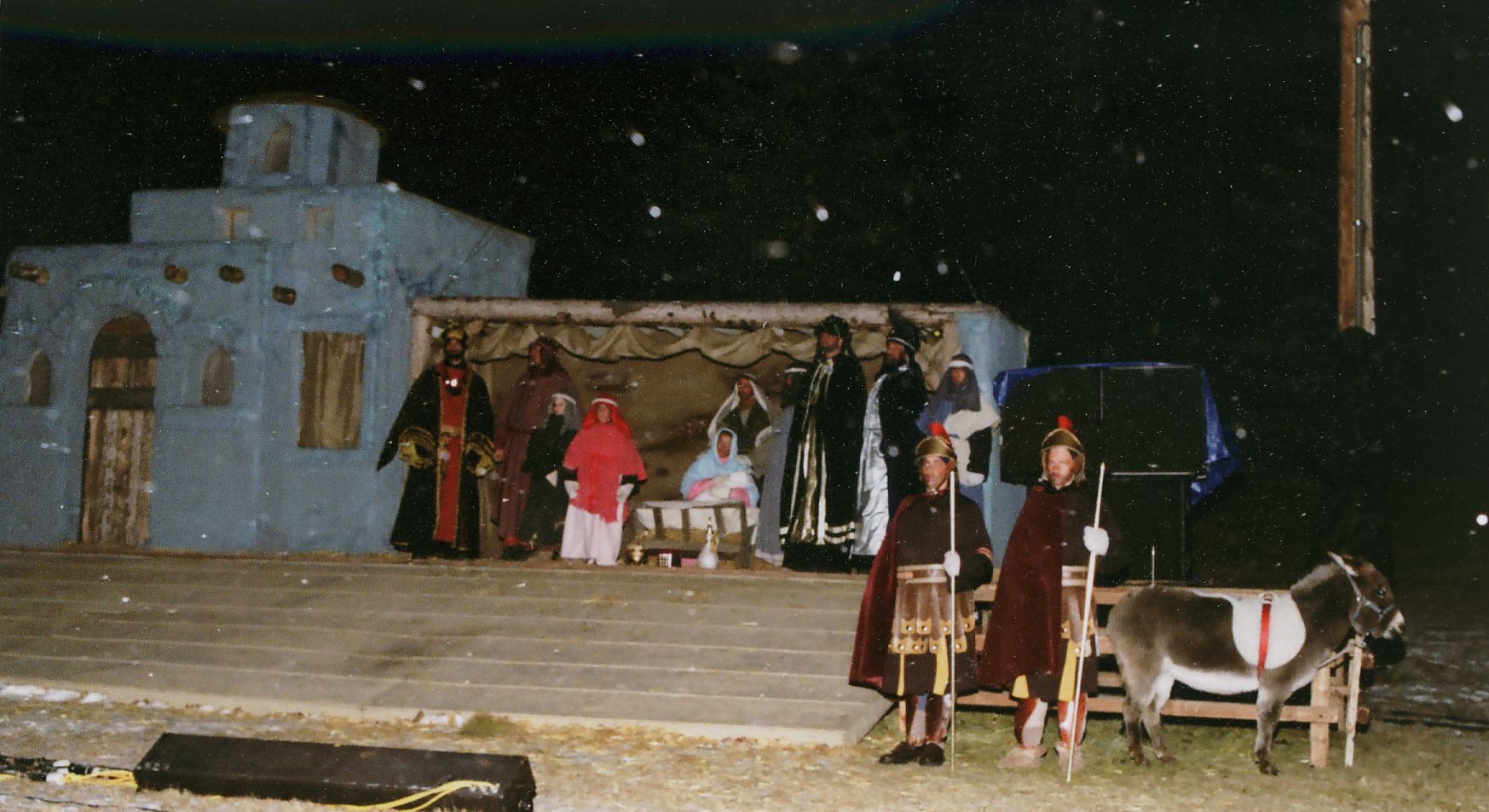 It was “a cold winter night and it began to snow.” The Calgary outdoor Nativity Pageant began in 1963 and has become a favourite Christmas tradition for many thousands of Calgarians. The event was still being performed annually in Heritage Park as of 2015. (Wayne Strong)
It was “a cold winter night and it began to snow.” The Calgary outdoor Nativity Pageant began in 1963 and has become a favourite Christmas tradition for many thousands of Calgarians. The event was still being performed annually in Heritage Park as of 2015. (Wayne Strong)
The Move Toward Service
As the Church became stronger in Calgary, it was able to devote more time and attention to community service. In addition to filling distinct needs in the community and allowing members to enjoy the benefits of service, these initiatives helped raise the stature and improve the image of the Church in the community.
Relief Society Service
In 1979, the Calgary Stake Relief Society was invited by the Calgary Stampede to present a grain-usage display in March at the agricultural fair, held on the Stampede grounds. Under the direction of Hellen Davis, over one hundred women helped staff the kitchen and give demonstrations every two hours for the duration of the six-day fair. An estimated fifty-one thousand people visited the fair, and the Relief Society received very favourable coverage in a number of newspaper articles.[151]
Beginning with the Relief Society sesquicentennial in 1992, women in Calgary Relief Societies focused more on community service. They made quilts and gave them to seniors, women’s shelters, and the Alberta Children’s Hospital (Calgary), and they sent some overseas. Personal care kits, winter coats for Jacket Racket, bags, baby clothing, and other essential items were donated to those in need. Sisters helped in community kitchens, sometimes in partnership with other organizations, such as Women in Need, and made sandwiches for a downtown homeless shelter. This work is ongoing.[152] During a service project in November 2014, Relief Societies across the city donated ten thousand books to low income families through a local organization, Families Matter. The final number of books collected greatly exceeded expectations, and organizers were “excited and overwhelmed.”[153]
From the 1980s on, members of the Church, primarily in the Calgary South Stake, provided significant help at the Drop-In Centre for the homeless. Adults and youth prepared food, helped raise several million dollars for a new facility, served on the board of directors, provided bedding, made quilts, donated books, and assisted in any way needed.[154]
Civic Involvement
In 1998, a plebiscite on video lottery terminals (electronic gaming devices) was held in conjunction with the Calgary civic election. Jim Gray, a local philanthropist, organized a petition against VLTs and was instrumental in having a plebiscite on the issue included on the election ballot.[155] Collecting names for the petition was difficult, and the LDS Church joined with other churches to encourage their members to participate. LDS members and a few others conducted a door-to-door campaign inviting Calgary citizens to vote on the issue, which generated a great deal of publicity and debate. Although voters in six Alberta municipalities were successful passing their anti-VLT plebiscites, the Calgary anti-VLT plebiscite did not pass. However, this venture in community political involvement resulted in Church members becoming more aware of the dangers of gambling and created stronger ties between the Church and other churches in the community.[156]
The Food Drive
In 1997, to commemorate the 150th anniversary of the Saints’ entry into the Salt Lake Valley, the Calgary Third Ward, in the Calgary West Stake, under the leadership of Bishop Jeff Jacob, held a successful food drive in which ward members collected $27,000 worth of food. Later, Bishop Jacob was successful in expanding the food drive into a Calgary West Stake project and a citywide initiative with all stakes and many LDS members—adults, youth, and children—participating. With outstanding organization and widespread support, the event was a resounding success. A family or individual member would sign up for a route and, in the week prior to food collection, place a plastic bag on the door of every home. The next week the food donations would be collected and a thank you card left. The entire effort typically took about four hours per person or family. In 2008, the Calgary food drive broke a Guinness world record when 509,147 pounds of food were collected in a single day. John N. Craig, president of the Calgary Foothills Stake, reflected on their accomplishment: “The appeal of the food drive was minimal effort by many people with a very worthy outcome, to feed our hungry. And thus we see that by small and simple things are great things brought to pass.”[157]
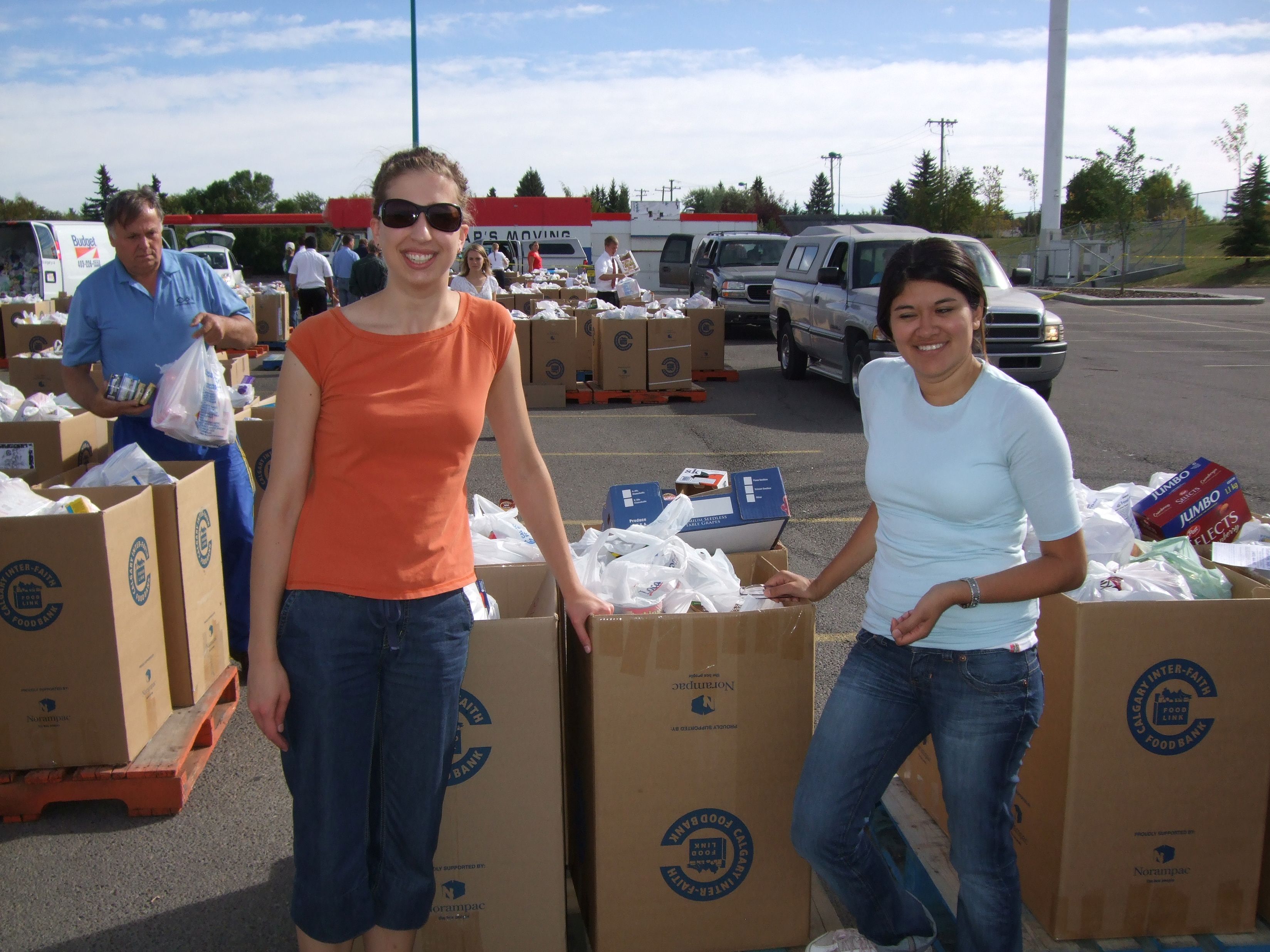 The Calgary stakes were particularly noted for spearheading successful food drives. They developed effective techniques that utilized large numbers of Latter-day Saints and other community volunteers in efficiently collecting and transporting record amounts of food. (Yogi Schultz)
The Calgary stakes were particularly noted for spearheading successful food drives. They developed effective techniques that utilized large numbers of Latter-day Saints and other community volunteers in efficiently collecting and transporting record amounts of food. (Yogi Schultz)
Hopes for a Temple Fulfilled
For many years, Church members in the Calgary area faithfully made the two-and-a-half-hour drive to Cardston to attend the temple. Like other Albertans, Calgarians loved the Cardston Temple and cherished their association with this sacred edifice. But, as the Church began building more temples throughout the world, Saints in Calgary dreamed of having a temple nearer to home.
In 1981, Lynn Rosenvall, president of the Calgary West Stake, purchased land in five locations on the outskirts of Calgary, anticipating future growth of the Church, as city bylaws prescribed that all available land within the central part of the city must be filled up before areas on the periphery could be developed. One of these tracts of land was a twenty-acre parcel in Rocky Ridge, bought at a price of $400,000. This site was unique in the Calgary area because it afforded an outstanding panorama from the Rocky Mountains in the west to downtown Calgary in the east. Rosenvall recalled that he had always harboured a fond hope that a temple would one day be built on that site.[158] In the 1990s, as a member of the Seventy, Gerald Melchin added the city of Calgary to the list of locations where temples might be built.[159]
In 1999, a second temple in Alberta, in the provincial capital of Edmonton, was dedicated by President Gordon B. Hinckley. Church members in Calgary recognized and agreed with Church leaders that a temple in Edmonton would greatly reduce the travel time for northern Albertans to attend the temple. The decision to build a temple in Edmonton was unanimously supported by the six stake presidents in Calgary.[160]
Nine years later, the patience and unselfishness of the Calgary Saints was rewarded. On 4 October 2008, at the opening session of the October general conference of The Church of Jesus Christ of Latter-day Saints, Thomas S. Monson, President of the Church, said, “This morning I am pleased to announce five new temples for which sites have been acquired and which, in coming months and years, will be built in the following locations: Calgary, Alberta, Canada . . .”[161] Members of the Church in Calgary, Alberta, and throughout Canada responded to the announcement with great joy and gratitude.
The groundbreaking for the temple was on 15 May 2010, the same month that one hundred years previously John and Florence Sheppard arrived in Calgary with their three young children, Jack, Laura, and Florence.[162] Under the direction of stake presidents, every stake, ward, priesthood quorum, and auxiliary in the Calgary region focused on preparing for the temple. This included clearing names for temple work, indexing, and many other family history related activities. Rehearsing for the prededication cultural celebration was a region-wide activity for the youth. Primaries were involved in creative activities celebrating the temple building and dedication
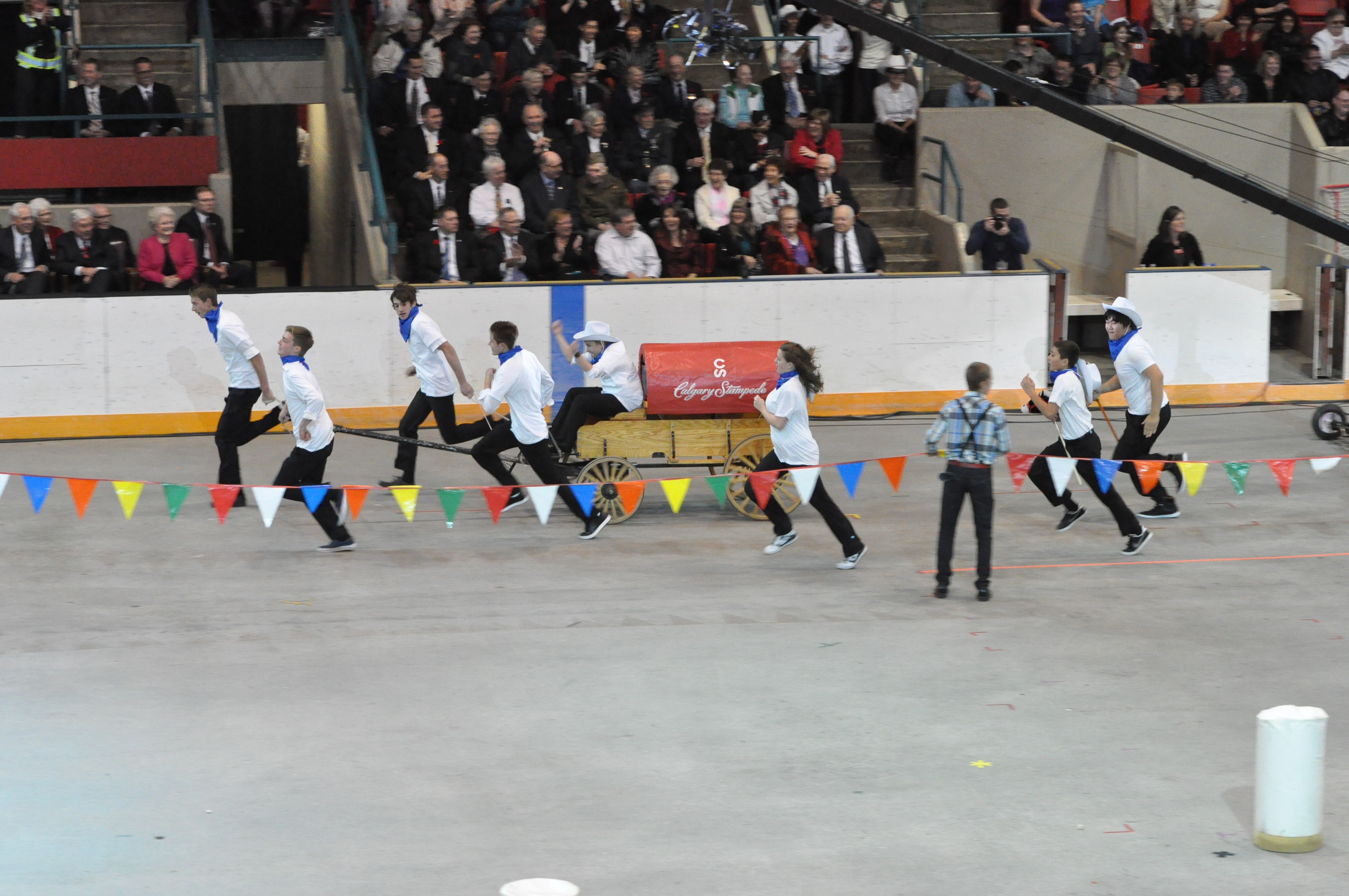 An enthusiastic group of 1,643 youth from the Calgary Temple district presented a memorable cultural celebration on 27 October 2012, the night before the dedication of the Calgary Temple. The event was held in the Stampede Corral in downtown Calgary and featured dancing, singing, fiddle music, white hats, chuck wagons, and live horses and cattle. The colourful program depicted the First Nations peoples, the Mounties, the Calgary Stampede, and the establishment and growth of the Church in the Calgary area.[163] (Colette Armsworthy)
An enthusiastic group of 1,643 youth from the Calgary Temple district presented a memorable cultural celebration on 27 October 2012, the night before the dedication of the Calgary Temple. The event was held in the Stampede Corral in downtown Calgary and featured dancing, singing, fiddle music, white hats, chuck wagons, and live horses and cattle. The colourful program depicted the First Nations peoples, the Mounties, the Calgary Stampede, and the establishment and growth of the Church in the Calgary area.[163] (Colette Armsworthy)
The Calgary Temple open house and dedication brought the members of the Church across the region together in a sweet spirit of love and unity. As the date for the open house drew near, officials realized that the temple would not be ready on time. They called for volunteers, and the response was overwhelming. For three weeks, members showed up by the hundreds to work inside or outside the temple, doing whatever was required. Some cleaned inside the temple; others planted shrubs; others swept and washed the sidewalks; others laid sod and spread mulch, all working together cheerfully to make the temple and its grounds finished, clean, and beautiful. One of the builders called the multitude of volunteers “God’s Army.”[165] And so they were. Many sacrificed to help out at the temple, even in small ways, and it made them much better people, more like Saints. After the workers and volunteers successfully made everything ready, the open house began on schedule. Just over one hundred thousand people visited the temple during the open house.[166]
There were no protesters at the Calgary Temple open house and dedication, a first for the Church. Certainly, there had been protests in Calgary before, at the Nativity Pageant for example. Latter-day Saints’ service to the Calgary community may have made the difference.
The Calgary Alberta Temple was dedicated on 28 October 2012 by President Thomas S. Monson. The first president and matron of the Calgary Temple were Blair and Jane Bennett.[167] The counselors and assistants were Ellis and Glenda Stonehocker and Richard and Carolyn Carter.
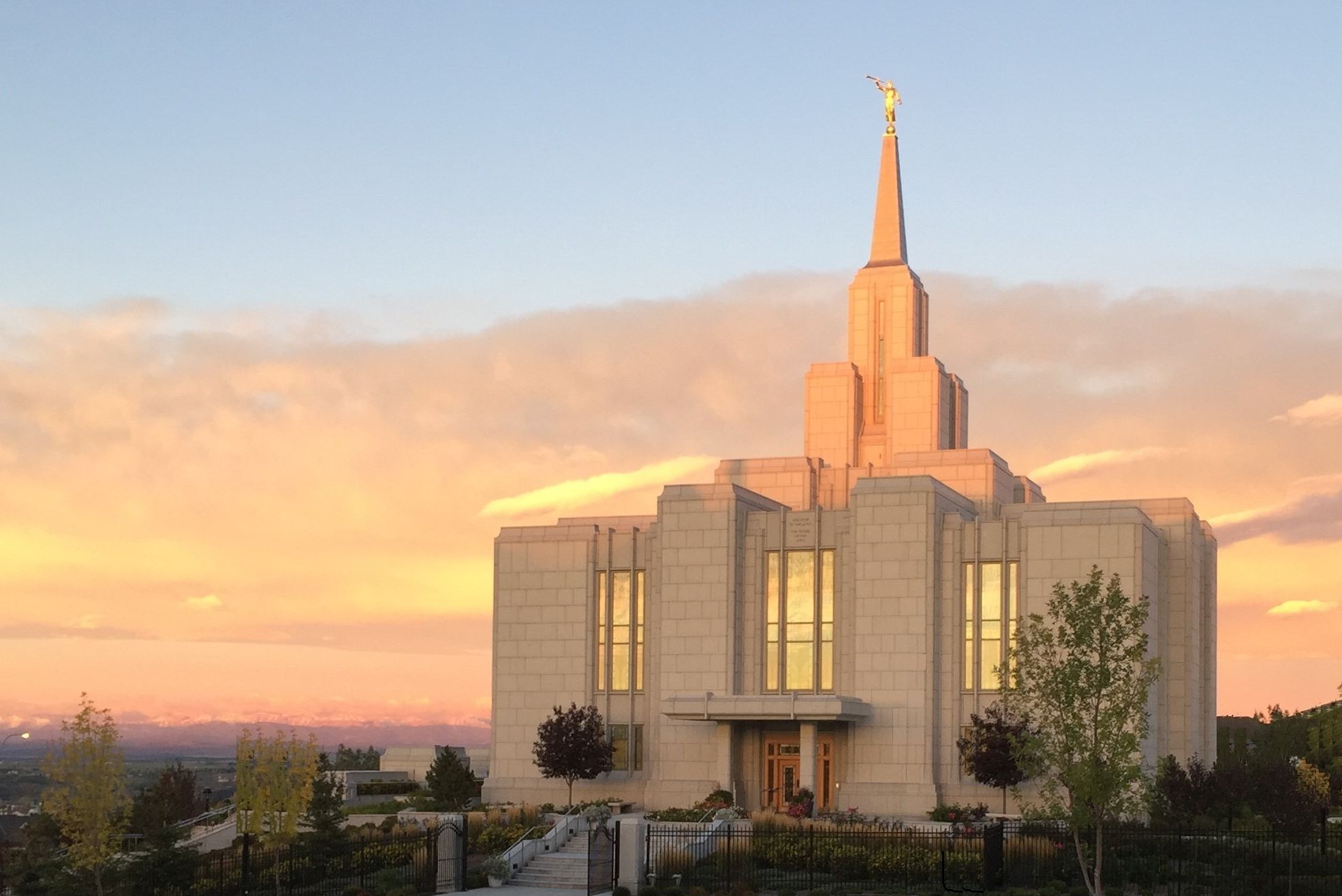 The Calgary Alberta Temple, announced in 2008, was dedicated in October 2012. The temple, built on an ideal location with a spectacular view of the city and the mountains, is a strength and a beacon to Church members in Calgary. (Robert Hamilton)
The Calgary Alberta Temple, announced in 2008, was dedicated in October 2012. The temple, built on an ideal location with a spectacular view of the city and the mountains, is a strength and a beacon to Church members in Calgary. (Robert Hamilton)
Church members in Calgary felt profound gratitude for the blessing of having their own temple. E. J. Wood, president of the Alberta Stake when the Cardston Temple was announced in 1913, had said, “I hope we appreciate the honor conferred upon us”[168] Similarly, in 2012, members of the Church in Calgary were determined to live worthy of having a temple in their midst. Having a third temple in Alberta was a further fulfillment of a prophecy of Jonathan Layne, an early settler in Cardston, who wrote on 19 June 1887 that the “Spirit of Prophecy” came upon him as he spoke in Sunday meetings that day and that he “predicted . . . that Temples would yet be built in this land. I could see it as plain as if it already was here.”[169] At the time, he and the Saints in Cardston were living in tents.
Over the years, growth sometimes caused sadness to members, as friends and relatives were frequently separated by ward and stake boundary realignments and rarely saw each other. Members might live in the same home for many years and yet, during that time, belong to five or six different wards and two or three stakes. With the new Calgary Temple, Church members enjoyed wonderful reunions as they attended the temple.
The Flood of 2013
In June 2013, unusually heavy and prolonged rains combined with a fast snowmelt brought devastating flooding along all of the rivers of southern Alberta, including the Bow and Elbow Rivers. Downtown Calgary was underwater, as was almost every home in High River. Many on the Siksika Nation and elsewhere along the rivers were also gravely affected by the flooding.[170] Many members of the High River Ward (Calgary Foothills Stake) were evacuated, some by helicopter. Members ended up staying with family and friends all over Alberta.
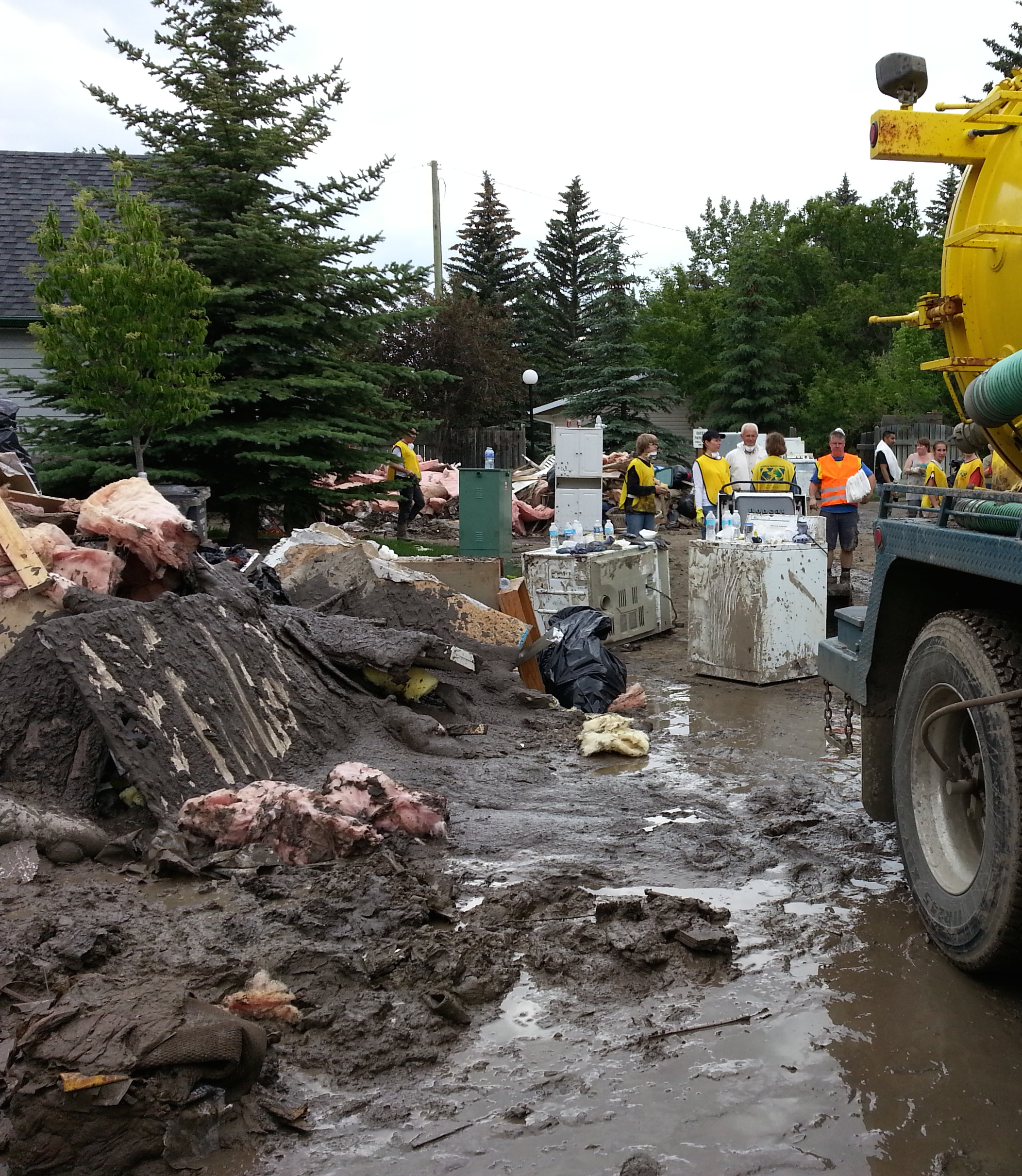 Latter-day Saints from a wide area in Alberta came to High River to assist in the mammoth cleanup effort following the devastating flooding in the spring of 2013. Wearing their distinctive yellow Helping Hands T-shirts, LDS volunteers worked tirelessly to remove debris and help residents of High River progress towards regaining their normal lives. (Ken Brown)
Latter-day Saints from a wide area in Alberta came to High River to assist in the mammoth cleanup effort following the devastating flooding in the spring of 2013. Wearing their distinctive yellow Helping Hands T-shirts, LDS volunteers worked tirelessly to remove debris and help residents of High River progress towards regaining their normal lives. (Ken Brown)
In the aftermath of the massive disaster, the task of cleaning up was widespread and overwhelming. Many victims of the flooding were unable to visualize how their lives could ever return to normal. But multitudes of volunteers came to their aid, including an army of Latter-day Saints, with many young single adults. Most volunteers wore LDS Helping Hands T-shirts. They became known as “the people who will help you for nothing.” Over fifty-three thousand hours of cleanup work were recorded, and many more unrecorded hours were donated by Church members. Volunteers came day after day for an extended period of time. There were over one thousand volunteers on some days. Both men and women worked humbly and unitedly to minister to the emotional, spiritual, and physical needs of the residents of High River, including members of the High River Ward and nonmembers as well. Most of the help came from the Calgary stakes, but many members, wards, and stakes elsewhere in Alberta also participated in the cleanup efforts.[171]
Conclusion
Just over a century ago, beginning with the arrival in Calgary of a single LDS family from England in 1910, followed by a few other families from southern Alberta, the establishment of the Church in Calgary had an inauspicious start. During World War I, several families moved out of the city to benefit from the favourable farm economy. But the end of the war brought a new revival, leading to the formation of an independent Calgary branch in 1921, the purchase of a little church the next year, and the creation of a small ward in 1923. While the little group flourished during the 1920s, the Great Depression led to the impoverishment of many of the members, who nonetheless worked together to support each other. Remarkably, the first LDS-designed chapel was built during those hard times and completed in 1939.
The Second World War brought prosperity to Calgary which became a thriving metropolis in the postwar period. The oil industry brought wealth, jobs and many people to Calgary from southern Alberta, from across Canada, and from around the world. Expansion of the missionary force in Western Canadian Mission after World War II led to an increase in convert baptisms. The first Calgary stake was formed in 1953, with oil executive and former Alberta Cabinet Minister N. Eldon Tanner as stake president. Fueled by the city’s rapid expansion—in recent times the fastest growing city in Canada—a new ward was formed on average every year thereafter so that by 2015 there were seven stakes in the Calgary area, with fify-eight wards and six branches and a membership of more than twenty-one thousand.
When Hugh B. Brown, the first president of the Lethbridge Stake, created the Calgary Ward in 1923, he prophesied a glowing future for The Church of Jesus Christ of Latter-day Saints in Calgary, and that prophecy is being fulfilled. The story of The Church of Jesus Christ of Latter-day Saints in Calgary has been marked by growth, progress, strong leadership, and continued building of the kingdom of God on earth. The climax of that development was the dedication of the magnificent Calgary Temple in 2012, a midsized temple, intended to provide the highest of spiritual blessings to an ever-growing population.
Members of the Church in Calgary reflect three groups: descendants of early LDS pioneers from southern Alberta; converts who joined the Church; and members who migrated to Calgary from within Canada or from other countries around the world. Many newly arrived members and recent converts are from Central or South America or Asia, especially China. The unity of Church members in Calgary was demonstrated as everyone worked together to prepare to attend the new temple and to help those who suffered in the floods of 2013. Members of the Church in Calgary enjoy the rich blessings of the gospel, as symbolized by their worship in the Calgary Temple and by living together in faith, humility, obedience, and service to others.
Notes
[1] This chapter is dedicated to the now mostly unknown LDS pioneers of the Calgary region and to all those who kept and shared their histories and made this chapter possible. Their names appear throughout.
I express my deep appreciation to Richard B. Vance, who conducted research on the Church in Calgary and the surrounding areas in the “Country Profile” project, while serving as a Church service missionary at the Church History Library, Salt Lake City, from 2014 to 2015.
[2] The Canadian Encyclopedia (Edmonton, Alberta: Hurtig Publishers, 1985), s.v. “Calgary”; Donald G. Godfrey and Brigham Y. Card, eds., The Diaries of Charles Ora Card: The Canadian Years 1886–1903 (Salt Lake City: University of Utah Press, 1993), 17. The quotation (edited to current usage) is that of Charles Ora Card during his 1886 visit.
[3] Jane Eliza Woolf Bates and Zina Alberta Woolf Hickman, Founding of Cardston and Vicinity (Cardston, Alberta: n.p, 1974), 1; Godfrey and Card, Diaries of Charles Ora Card, xxxviii.
[4] Godfrey and Card, Diaries of Charles Ora Card, 71.
[5] Godfrey and Card, Diaries of Charles Ora Card, 263.
[6] Frankburg Ward Manuscript History and Historical Reports (hereafter FWMHHR), 1904, Church History Library (hereafter CHL), LR 2983 2.
[7] Olive Wood Nielson, ed., A Treasury of Edward J. Wood (Salt Lake City: Publishers Press, 993), 342.
[8] Jacqueline McLellan, granddaughter of John Carter Robbins, interview by Linda Davis, 27 February 2015; “Charles White Hinman,” in Chief Mountain Country: A History of Cardston and District (Calgary: Cardston and District Historical Society, 1978), 344.
[9] Edward J. Wood to Philip Sheffield, 30 August 1905, in Lenora A. Sheffield Duce, Oral History (Salt Lake City: James Moyle Oral History Program, 10 March 1974), appendix.
[10] G. Homer Durham, N. Eldon Tanner: His Life and Service (Salt Lake City: Deseret Book, 1982), 21–22.
[11] Florence Sheppard Lamb, A Brief History of John Hollister Sheppard, 1872–1948 (Calgary: Glenbow Museum and Archives, October 1973), 1.
[12] Noreen C. Burton, “History of Harold August Christensen” (Harold E. Christensen Family, 1993), http://
[13] Calgary Ward manuscript history and historical reports (hereafter CWMHHR), 1913, CHL, LR 1307 2.
[14] CWMHHR, 1913 and 1929, CHL, LR 1307 2; Nielson ed., Treasury of Edward J. Wood, 385–86.
[15] Lethbridge Stake, A History of the Mormon Church in Canada (Lethbridge, Alberta: Lethbridge Herald, 1969), 175.
[16] CWMHHR, 1913, 1914, 1920, CHL, LR 1307 2.
[17] “Irving Fuller Christensen Autobiography” (Harold E. Christensen Family, 1980, http://
[18] “Harold Elijah Christensen Autobiography” (Harold E. Christensen Family, 1993), http://
[19] John B. Faulkner, Attestation Paper of Canadian Over-Seas Expeditionary Force, First World War Archive, National Library of Canada.
[20] Lamb, History of John Hollister Sheppard, 2.
[21] Eugene E. Campbell and Richard D. Poll, Hugh B. Brown: His Life and Thought (Salt Lake City: Bookcraft, 1975), 61–62.
[22] Lamb, History of John Hollister Sheppard, 3.
[23] Asael E. Palmer, interview by Charles Ursenbach, 2–3 June 1973, transcript of interview, 24–25, Glenbow Museum and Archives, Calgary, Alberta, M-7203-103.
[24] G. Ellingson, comp., The Berg Ellingson Family (Orem, UT: TriQuest Publishing, 2003), 24, 53, 61.
[25] Lamb, History of John Hollister Sheppard, 3.
[26] Lethbridge Stake, Mormon Church in Canada, 132–33, 176.
[27] CWMHHR, 1921, CHL, LR 1307 2.
[28] Charles Ursenbach, interview by Harold O. Merkley, 18 June 1981, Glenbow Museum and Archives.
[29] Cathy Swendsen, “Our Heritage of Faith: A History of Relief Society in Calgary,” typescript, April 1997, October 2012, 1.
[30] Calgary Ward Relief Society minutes and records, 1923–25, CHL, LR 1307 14.
[31] V. A. Wood, The Alberta Temple: Centre and Symbol of Faith (Calgary, Alberta: Detselig Enterprises, 1989) 192–93.
[32] Lethbridge Stake, Mormon Church in Canada, 177–78.
[33] Frank Pratt, “A History of the Church in Alberta” (unpublished manuscript in author’s possession, 1989), 8.
[34] Wood, Alberta Temple, 192–93.
[35] Ellingson, Berg Ellingson Family, 24.
[36] Ellingson, Berg Ellingson Family, 24; Lethbridge Stake, Mormon Church in Canada, 143.
[37] Lethbridge Stake, Mormon Church in Canada, 140.
[38] Calgary Ward, Record of Members, 1922-1941, Charles Easton Black, Calgary Ward Membership Records, #142; Ida Alean Obray, Calgary Ward Membership Records, #135, Family History Library, film #105364.
[39] Lethbridge Stake, Mormon Church in Canada, 143.
[40] Lethbridge Stake, Mormon Church in Canada, 143.
[41] CWMHHR, 1929, CHL, LR 1307 2.
[42] Lucile H. Ursenbach, My Story, 30, 1981, Charles Ursenbach Fonds and Oral Histories, Series 1, Glenbow Museum and Archives, M-7203-168; Maisie Ramona Tynan Jones, Memories of the Crescent Heights Chapel (unpublished manuscript, n.d.), 2.
[43] Lucile Ursenbach, My Story, 39; Shirley Sallenbach Stevenson, “Heritage of Faith: Otto and Ivy Sallenbach” (unpublished manuscript, 1998).
[44] Walter C. Meyer, Memories of My Eighty Years (Edmonton, Alberta: 2011), 12.
[45] Elsa Arm Meyer, The Arm Connection (Edmonton, Alberta: 2007).
[46] Canadian Encyclopedia, s.v. “The Great Depression.”
[47] Lola Fay McPhee, interviewed by Charles Ursenbach, 1973, CHL, OH 255. In January and February 1931, six large families from Frankburg moved to Calgary. (Ursenbach, 1977, 9.)
[48] Autobiography of Charles Ursenbach, 62.
[49] Maisie T. Jones, Maisie Ramona Tynan Jones Autobiography (unpublished manuscript, 2012).
[50] Ron and Hellen Davis, interviewed by Linda Davis, 2012.
[51] Calgary Ward Reports to the Lethbridge Stake, 31 December 1932, 30 June 1933, and 30 September 1934, Calgary Ward MHHR, CHL, LR 1307 2.
[52] Janet Boucher, Janet Leah Hamilton Boucher Life Story, 1975, 9–10, Janet Leah Hamilton, KWZQ-BWC, Memories, FamilySearch, www.familysearch.org.
[53] Boucher, Janet Boucher Life Story, 28.
[54] CWMHHR, 30 September 1936, CHL, LR 1307 2.
[55] Glenda Korella, Fredda Kenney’s Memories, email, 8 October 2012, in author’s possession.
[56] Charles Ursenbach, interview by William G. Hartley, 5–7 April 1973, Glenbow Museum and Archives, Calgary, Alberta, 54.
[57] Morgan R. Ririe, email to Linda Davis, 1 September 2012, “Early Memories of the Latter-day Saints and Buildings in Calgary,” in possession of author.
[58] Lucile Ursenbach, My Story, March 1981, 30.
[59] Boucher, Janet Boucher Life Story, 12.
[60] Personal knowledge of author.
[61] Charles Ursenbach, interview by Harold O. Merkley, 2.
[62] Morgan H. Pitcher, “Life of Morgan Hinman Pitcher,” 82, unpublished autobilgraphy, typescript in possession of author.
[63] Pitcher, Life of Morgan Hinman Pitcher, 82–83.
[64] FWMHHR, 1936, CHL, LR 2983 2.
[65] Pitcher, Life of Morgan Hinman Pitcher, 82–83.
[66] CWMHHR, Quarterly Report, 30 September 1937, CHL, LR 1307 2.
[67] Doral William Pilling, interviewed by Charles Ursenbach, 89, CHL, OH 128; Mary Josephine Quist, KWCD-B5F, familysearch.org.
[68] CWMHHR, 30 September 1937, CHL, LR 1307 2.
[69] Pratt, “History of the Church in Alberta,” 8.
[70] CWMHHR, 31 December 1937, CHL, LR 1307 2.
[71] Pitcher, Life of Morgan Hinman Pitcher, 86.
[72] Charles Ursenbach, interviewed by William G. Hartley, 5, 6, 9 April 1973, 59, CHL, OH 97; Doral William Pilling, interviewed by Charles Ursenbach, 89, CHL, OH 128.
[73] Lamb, History of John Hollister Sheppard, 5.
[74] Pitcher, Life of Morgan Hinman Pitcher, 86.
[75] Ririe, Early Memories, 1 September 2012.
[76] Walter Meyer, Memories, 166.
[77] Stevenson, “Otto and Ivy Sallenbach”; Walter Meyer, Memories, 335–36; Robert Dudley, interview by Linda Davis, 2012; Ririe, Early Memories, 1 September 2012; Maisie T. Jones, Maisie Ramona Tynan Jones Autobiography.
[78] Harold Enders Kearl, interview by Harold O. Merkley, 16 June 1981, 1–2.
[79] Lethbridge Stake, Mormon Church in Canada, 150.
[80] Swendsen, “Relief Society in Calgary,” 12.
[81] Lethbridge Stake, Mormon Church in Canada, 150.
[82] Charles Ursenbach, interview by William G. Hartley, 40–42. Doral Pilling was a former Olympian who represented Canada in the 1928 Amsterdam Olympic Games in the javelin event.
[83] Korella, Fredda Kenney’s Memories.
[84] Florence Caroline Hyde (Sheppard) typescript in author’s possession; Lamb, History of John Hollister Sheppard, 1872–1948, 4.
[85] Lethbridge Stake, Mormon Church in Canada, 152–53.
[86]“Turner Valley Oilfield Discovery Celebrated 100 Years Later,” CBC News, 13 May 2014, cbc.ca/
[87] Wayne Nysetvold, interview by Roy Prete, 20 April 2016.
[88] Lethbridge Stake, Mormon Church in Canada, 178.
[89] Western Canadian Mission, Canada Calgary Mission, Manuscript History and Historical Reports (hereafter WCM, CCMMHHR), box 1, fd. 1, 1941, 15 May 1942.
[90] Wilbur Gordon Hackney, “History of the Western Canadian Mission” (master’s thesis, Brigham Young University, 1950), 78, 86, 131, 135, 146, 163, CHL, M277.11 H123h.
[91] WCM, CCMMHHR, box 2, vol. 3, folder 2, report of 30 September 1962, 31 July 1962, CHL, LR 10539 2.
[92] Canada Edmonton Mission, historical information, Church Directory of Organizations and Leaders (CDOL), 14 April 2016, www.cdol.org.
[93] Calgary Alberta Stake Manuscript History and Historical Reports (hereafter CASMHHR), box 1, November–December 1953, CHL, LR 18749 2. See also Durham, N. Eldon Tanner, 166–69.
[94] CASMHHR, box 1, November–December 1953, CHL, LR 18749 2. See also Durham, N. Eldon Tanner, 166–69.
[95] CASMHHR, box 1, November–December 1953, CHL, LR 18749 2. See also Durham, N. Eldon Tanner, 166–69.
[96] CASMHHR, box 1, November–December 1953, CHL, LR 18749 2. See also Durham, N. Eldon Tanner, 166–169.
[97] Durham, N. Eldon Tanner, chapters 4–8.
[98] Durham, N. Eldon Tanner, 170.
[99] Charles Ursenbach, interview by Harold O. Merkley, 18 June 1981, 3–4.
[100] Durham, N. Eldon Tanner, 170.
[101] Swendsen, “Relief Society in Calgary,” 18.
[102] Harold Kearl, interview by Charles Ursenbach, 1981, Glenbow Museum and Archives, Calgary, Alberta, 3.
[103] Lethbridge Stake, Mormon Church in Canada, 179–84.
[104] Beth Tanner Spackman, “Two Incidents,” typescript, September 2012, in possession of author.
[105] Durham, N. Eldon Tanner, 170–73.
[106] Autobiography of Charles Ursenbach, 85.
[107] “Caravan from Calgary,” Church News, 18 October 1958, 14.
[108] Harold Kearl and Marilyn Kearl, comps. “A Pioneer Story,” 5–6, typescript in possession of author.
[109] Kearl and Kearl, “A Pioneer History,” 4–10.
[110] Kearl and Kearl, “A Pioneer History,” 31.
[111] Lethbridge Stake, Mormon Church in Canada, 190.
[112] Olson, Calgary South Stake History (2012), in Calgary Alberta Temple History, CHL, CR 972 3.
[113] Kearl, “A Pioneer History,” 31.
[114] Kearl, “A Pioneer History,” 6.
[115] Calgary Stake History, 2012, in Calgary Alberta Temple History, CHL, CR 972 3; Personal knowledge of author, who was a member of the ward for many years.
[116] Judy Makarenko, “Talk on Pioneers,” 24 July 1994, in author’s possession.
[117] “Work Among our Native Members,” Calgary East Stake History (2012), in possession of author.
[118] Calgary North Stake History (n.p., 2012), in Calgary Alberta Temple History, CHL, CR 972 3.
[119] Recollections of author, 17 June 2016.
[120] Ron and Hellen Davis, interview by author, 2012.
[121] Charles Ursenbach, interview by William G. Hartley, 45–47.
[122] Kearl, “A Pioneer History,” 30.
[123] “900 Participate in Canadian Solemn Session,” Church News, 9 August 1975, 10.
[124] “900 Participate,” Church News, 9 August 1975, 10.
[125] Ellis Stonehocker, former stake president, conversation with author.
[126] Calgary Alberta West Stake, Calgary Alberta Fish Creek Stake, Calgary Alberta Confederation Park Stake, Calgary Alberta Foothills Stake, and Calgary Alberta Bow River Stake, Positions and Historical Information, CDOL, consulted 8 April 2016, cdol.lds.org.
[127] Author’s personal observations, 17 June 2016.
[128] Calgary Stake Directories, (2012); personal knowledge of author.
[129] Lynn Rosenvall, email to Linda Davis, 6 February 2017 (information from Church History Library obtained by Rea Skelton, Regional Church History Adviser); Personal knowledge of author.
[130] Kearl, “A Pioneer History,” 9–10.
[131] “Crescent View Ward,” in Calgary North Stake History (2012), 29, in Calgary Alberta Temple History, CHL, CR 972 3.
[132] Personal knowledge of the author.
[133] “Calgary is a Young City, and It’s Not Getting Much Older,” Calgary Economic Development, calgaryeconomicdevelopment.com/
[134] G. Lawrence Spackman, Area Seventy, email to Linda S. Davis, 25 April 2016.
[135] Lynn A. Rosenvall, email to Roy A. Prete, 29 September 2016.
[136] Rosenvall, to Prete, 29 September 2016; “Teddy E. Brewerton,” Deseret News 2008 Church Almanac, 93, 96; “Gerald R. Melchin,” Deseret News 2008 Church Almanac, 96; “The Sixth Quorum of the Seventy,” Deseret News 2013 Church Almanac, 110; G. Lawrence Spackman, CDOL, consulted 18 January 2017, cdol.lds.org.
[137] “The Saturday Night Dance,” Calgary Alberta Stake History (2003), in author’s possession.
[138] Kearl, “A Pioneer Story,” 26.
[139] Harold Kearl, sacrament meeting talk, 24 July 2011, 4.
[140] Canadian Jamboree, wolo.scouts.ca/
[141] “News of the Church,” Ensign, October 1981, 79–80.
[142] “15th World Scout Jamboree,” Wikipedia, accessed 12 May 2016, en.wikipedia.org/
[143] Gordon West, Memories, in Calgary North Stake History (2012), 5, in Calgary Alberta Temple History, CHL, CR 972 3.
[144] Kearl, “A Pioneer Story,” 31–32.
[145] Swendsen, “Relief Society in Calgary,” 20–21.
[146] Calgary Alberta Stake History (2012), in Calgary Alberta Temple History, CHL, CR 972 3; also “A Pioneer Story,” compiled by Harold and Marilyn Kearl, 1997, see chapter “Faith in Every Footsteps: Cultural Events.”
[147] Calgary Alberta West Stake History (2012), 51–52, in Calgary Alberta Temple History, CHL, CR 972 3.
[148] “As We See It . . . ‘In Calgary, Canada,’” Church News, 4 January 1964, 5.
[149] Garry Ursenbach, Topic Summary: The Nativity Pageant, 2005, in possession of author; Calgary Nativity Pageant, various reports by stakes and individuals, including Simon Dewey, Lorna Pratt, and the Davidson family. Handwritten stake and ward reports are not published, and are in possession of author.
[150] Garry Ursenbach, “The Calgary Nativity Pageant, Report for the Stake Presidents in Calgary,” (1963–2009), in author’s possession.
[151] Swendsen, “Relief Society in Calgary,” 24.
[152] Swendsen, “Relief Society in Calgary,” 26.
[153] “Families Matter Receives 10,000 Books from Mormon Women in Calgary,” Mormon Newsroom, 25 November 2014, http://
[154] Debbie Newman, “Report on the Assistance of The Church of Jesus Christ of Latter-day Saints to the Drop In Centre,” August 2012, copy in author’s possession.
[155] “Rolling the Dice: Alberta's Experience with Direct Democracy and Video Lottery Terminals,” Canada West Foundation, September 1998, 40–41, http://
[156] “Rolling the Dice,” Canada West Foundation, September 1998, 40–41, http://
[157] John N. Craig, “History of the Calgary Stakes Food Drive,” 7 October 2012, copy in author’s possession.
[158] Lynn Rosenvall, interview by Linda Davis, 28 April 2012; see also Lynn Rosenvall, Keynote address at 2012 Mormon History Association meeting, Calgary, AB, at https://
[159] Richard K. Melchin, “Address at Mormon History Conference (Calgary, Alberta Canada 30 June 2012),” notes in author’s possession.
[160] Richard K. Melchin, Comments during Calgary Open House and Dedication Committee Meeting, 2012.
[161] Thomas S. Monson, “Welcome to Conference,” Ensign, November 2008, 6.
[162] John and Florence Sheppard, Megantic, White Star Line, departed Liverpool 14 May 1910, arrived in Montreal 1910-05-22, Passenger Lists 1865–1922, Canadian National Library and Archives, bac-lac.gc.ca/
[163] Gerry Avant, “Celebrating on the Eve of Calgary Temple’s Dedication,” Church News, 4 November 2012, 7–9.
[164] “The High River Primary Temple Trip September 22, 2012,” in author’s possession.
[165] Jason Swensen, “Enthusiasm for Temple,” Church News, 30 September 2012, 10;
“Mormon Temple offers Sneak Peek,” Calgary Herald, 27 September 2012, cover and A3.
[166] “Calgary Temple to be Dedicated after 100,000+ Take Tours,” Mormon Newsroom, 26 October 2012, http://
[167] “Church President Dedicates 140th Temple,” Mormon Newsroom, 28 October 2012, http://
[168] Nielson ed., Treasury of Edward J. Wood, 30.
[169] D. Leland Layne, Jonathan Ellis Layne and His Descendants (Logan, Utah: Unique Printing Service, 1969), 29.
[170] “The Flood of 2013: A Summer of Angry Rivers in Southern Alberta,” The Calgary Herald, 2014.
[171] Linda Davis, Calgary Foothills Stake History (2013), Calgary Alberta Temple History, Stake Reports and Histories, CHL, CR 972 3.
